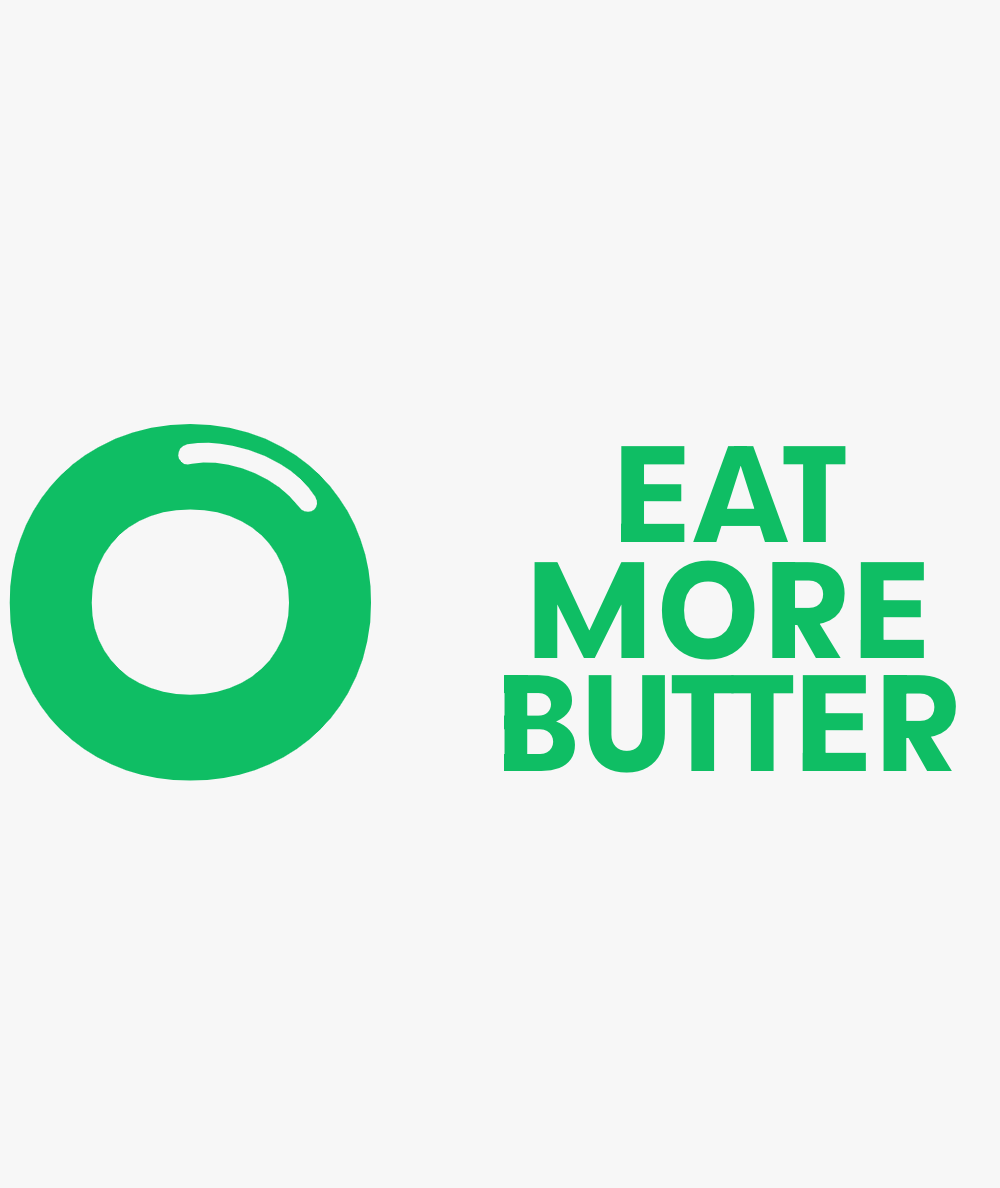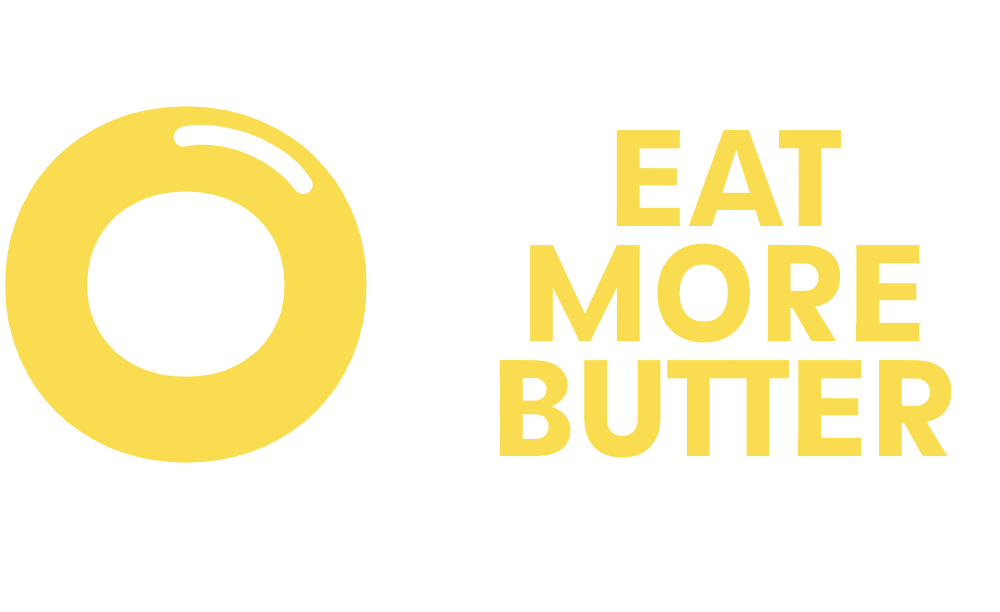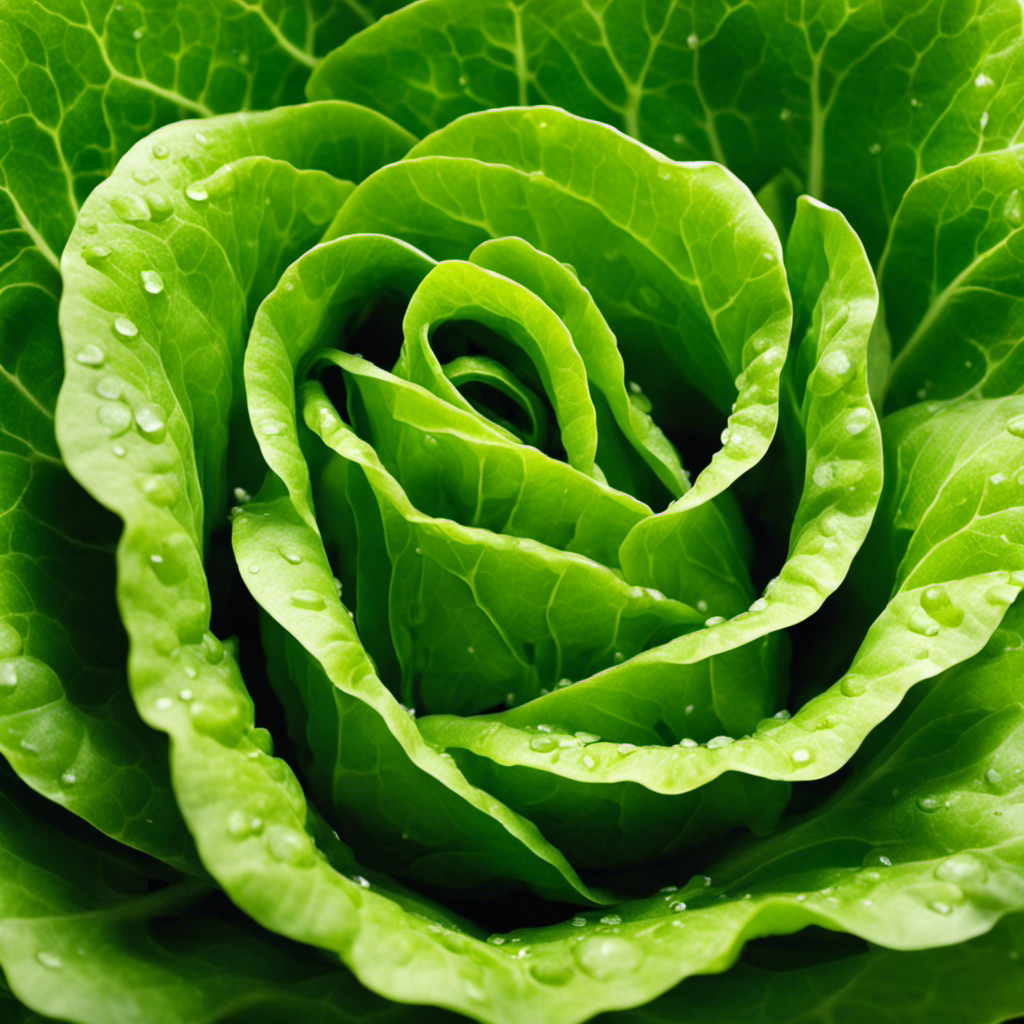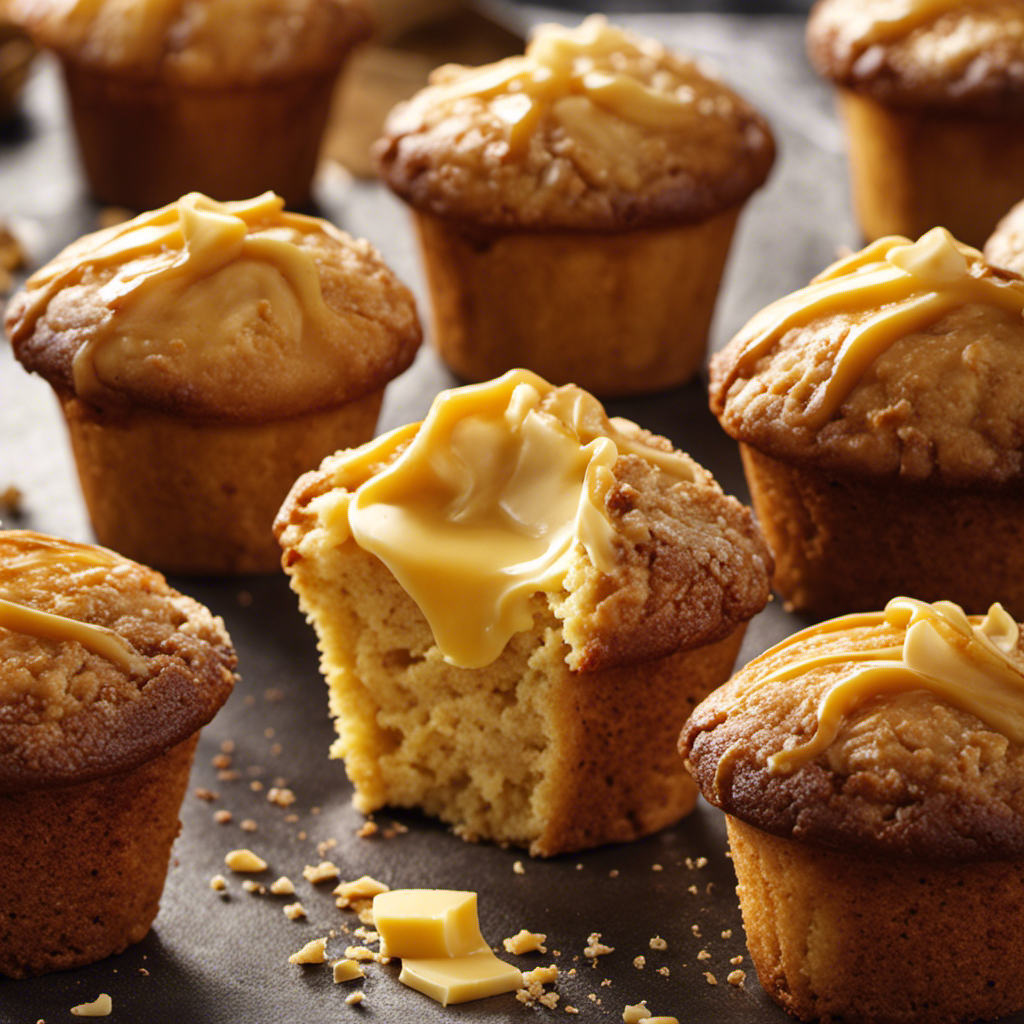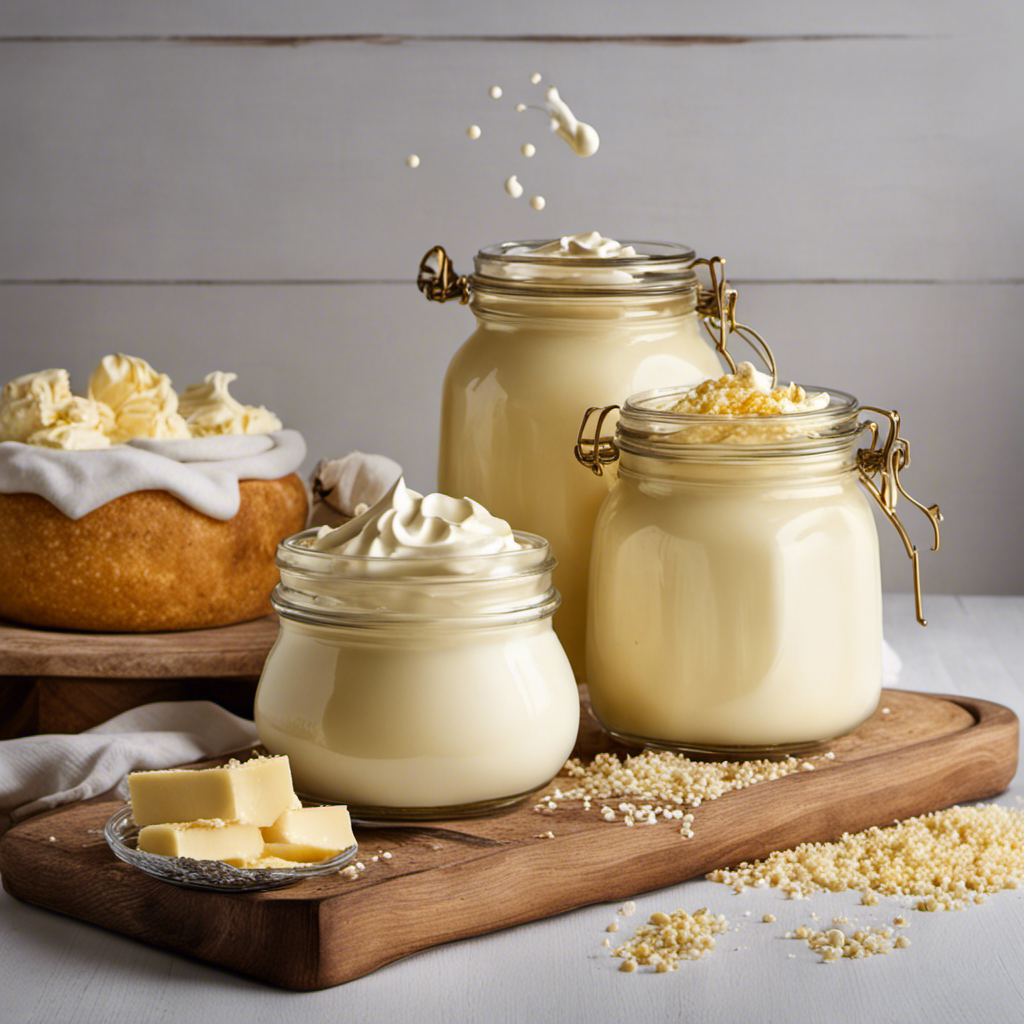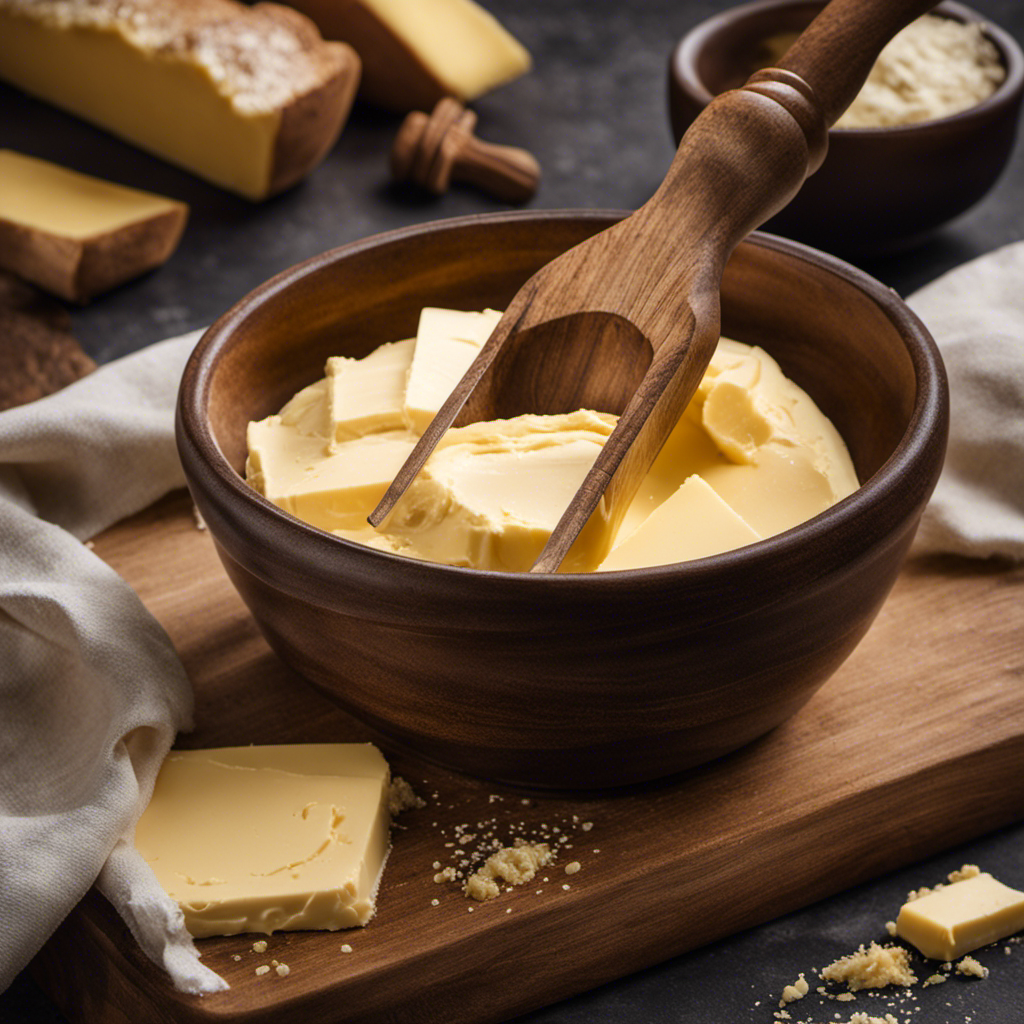Butter Basics
Cooking Tips: At What Temperature Does Butter Burn?
Find out at what temperature butter burns and how to prevent it for perfectly cooked dishes – a must-know for any home cook!
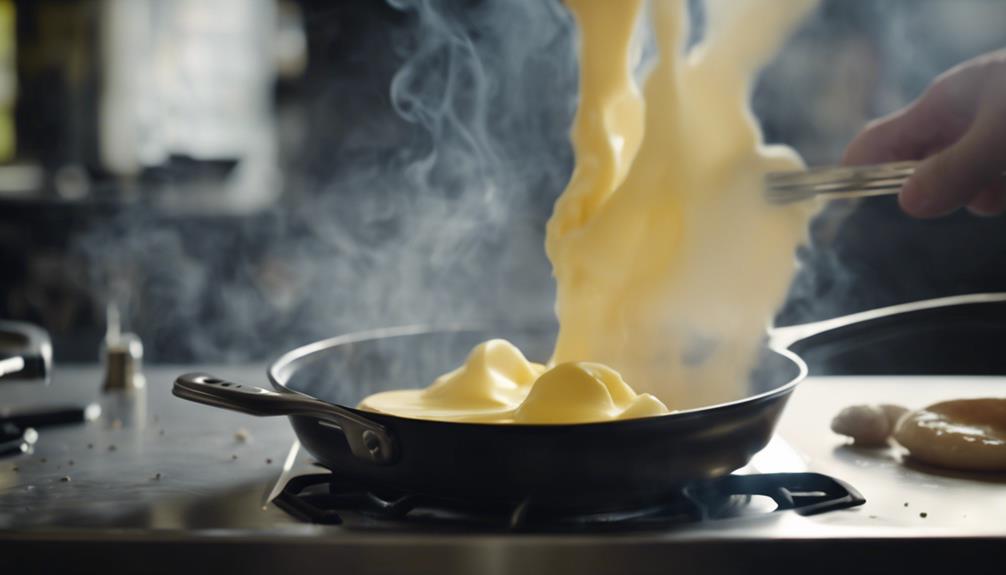
When cooking, remember butter burns at 350°F, also called the smoke point. Going above that can give your dishes a burnt taste. Make sure to watch the heat closely to avoid burning. Keeping the temperature below 350°F prevents the butter from burning. If you want to enhance your knowledge further on butter types, cooking tips, and substitutions, there's more valuable information waiting for you.
Key Takeaways
- Butter burns at 350°F, known as its smoke point.
- Cooking above 350°F can result in a burnt taste.
- Monitoring temperature is crucial to prevent burning.
- Using clarified butter (ghee) with a 485°F smoke point avoids burning.
- Keeping heat below 350°F is essential to prevent butter from burning.
Butter Burning Temperature
When cooking, it's important to be aware that butter burns at 350°F. This temperature is known as the smoke point of butter, which is the temperature at which it starts to break down and produce smoke. Cooking with butter above this threshold can result in a burnt taste and undesirable flavors in your dishes. It's essential to monitor the temperature carefully when using butter to avoid reaching this smoke point.
Butter's unique composition, solid at room temperature and fluid when heated, makes it a versatile ingredient in cooking. However, its sensitivity to high temperatures means that it requires careful attention. By keeping the heat below 350°F, you can prevent the butter from burning and guarantee that your dishes maintain their intended flavors.
Being mindful of butter's burning point is necessary for achieving the best outcomes in your cooking. By understanding this temperature limit, you can use butter effectively in various recipes without compromising on taste and quality.
Types of Butter for Cooking
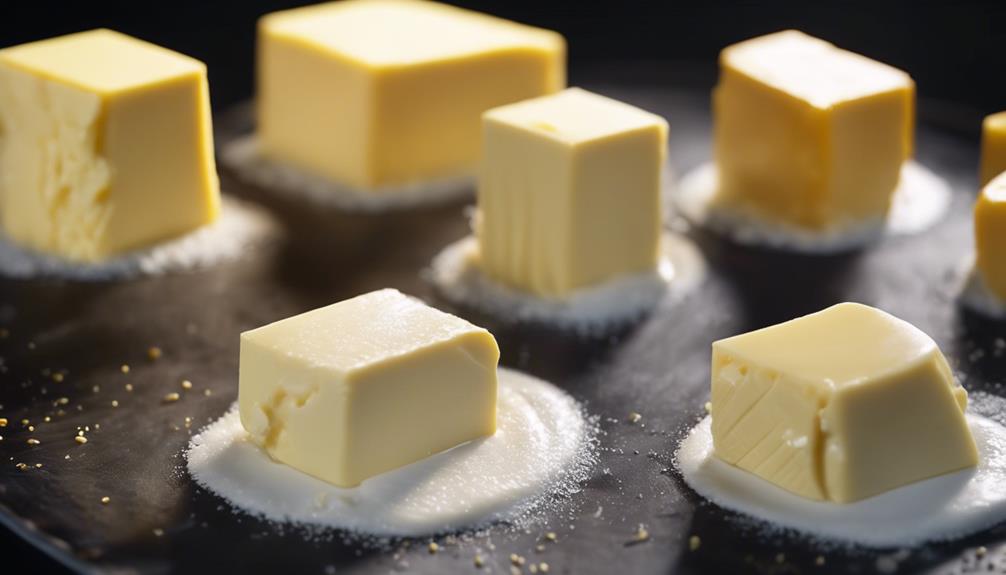
When cooking, knowing the types of butter available can greatly impact your dishes. Different butters like unsalted, salted, and clarified butter each have unique uses in the kitchen.
Understanding these variations is key to achieving the best flavors and textures in your cooking.
Butter Burning Temperature
Butter varieties for cooking vary in their burning temperatures, with clarified butter (ghee) recognized for its higher smoke point compared to regular butter. Regular butter burns at 350°F, which is important to note to prevent dishes from tasting burnt.
When cooking at high heat, it's vital to take into account the butter's burning temperature to avoid compromising the flavor and aroma of your meals. Clarified butter, or ghee, stands out for its high smoke point at 485°F, making it a preferred choice for recipes that require intense heat.
While butter offers omega fatty acids beneficial for brain health and memory enhancement, burning it can lead to the formation of harmful compounds. To preserve the nutritional benefits and taste of butter in your cooking, understanding the burning temperatures of different butter varieties is crucial.
Butter Types Overview
For best control over salt content in your baking and cooking, using unsalted butter is recommended. When it comes to butter types, there are various options to contemplate based on your cooking needs. Salted butter is great for spreading and condiments, while unsalted butter allows you to adjust the salt content in your recipes.
If you're looking for a butter with a high smoke point for high-temperature cooking, clarified butter, like ghee, is an excellent choice. Ghee is pure butterfat with a smoke point of 485°F, making it ideal for grilling and sautéing at high heats without burning. Compared to regular butter, ghee is more stable, producing fewer harmful free radicals and even aiding in faster healing of burn injuries.
Understanding the different butter types and their characteristics can help you choose the right one for your specific cooking needs.
Butter Substitutes Guide
Consider incorporating different types of butter substitutes in your cooking for added versatility and flavor profiles. Unsalted butter is perfect for precise baking and cooking control, while clarified butter, also known as ghee, boasts a high smoke point of 485°F, making it ideal for grilling and sautéing.
Butter, solid at room temperature, burns at 350°F, whereas ghee is more stable and produces fewer harmful free radicals. When it comes to baking at low heat, butter can be your go-to choice, but for high-temperature cooking methods, such as searing or frying, ghee is the preferred option due to its high smoke point.
Understanding the differences between these butter substitutes can help you enhance the flavors in your dishes and achieve best cooking results. Next time you're in the kitchen, experiment with using unsalted butter for delicate pastries and clarified butter for that perfect sear on your meats.
Baking With Butter Tips
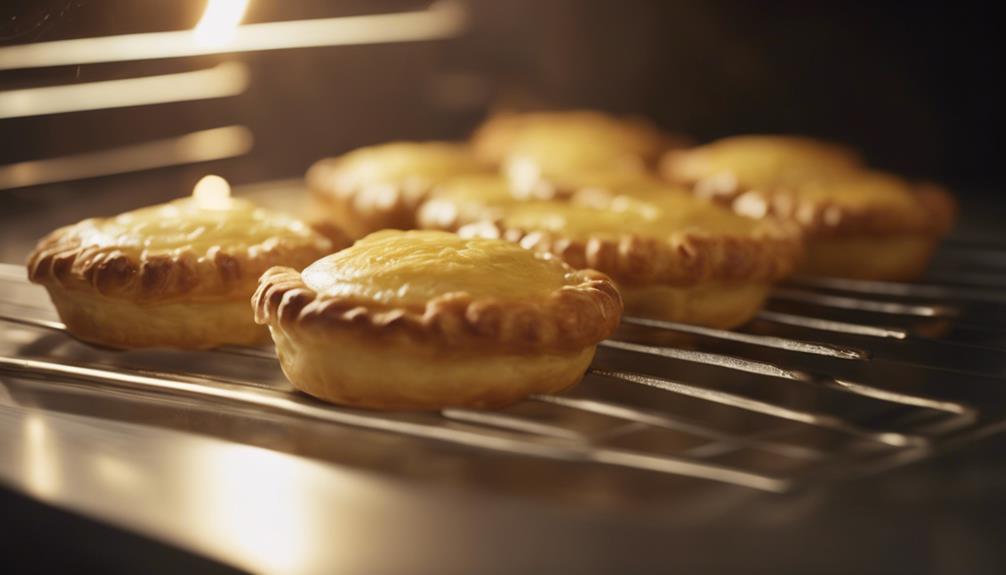
When baking, it's important to know the burning temperatures of butter to prevent mishaps in your recipes.
Using room temperature butter guarantees smooth blending into your baking creations.
Butter Burning Temperatures
Keep a watchful eye on the temperature when working with butter to avoid burning it at 350°F, important for successful baking and cooking outcomes. High temperatures can cause butter to burn quickly, impacting the taste and texture of your dishes.
When cooking or baking with butter, maintaining the right temperature is vital to prevent burning and guarantee your recipes turn out just right. Butter's burning point isn't only about taste; it can also affect the nutritional properties of your dish, so handle it with care to preserve its benefits.
Butter for Baking
Monitor the temperature carefully when baking with butter to achieve optimal results in your baked goods. When using butter for baking, keep in mind the following tips:
- Room Temperature Butter: Allow butter to reach room temperature before using it in baking recipes. Softened butter blends easily with other ingredients, creating a smooth batter or dough.
- Melting Butter: Melt butter gently over low heat or in short intervals in the microwave to prevent overheating. Be cautious as overheated butter can lead to burnt or unevenly baked goods.
- Chilled Butter: For recipes that require chilled butter, such as pie crusts or pastries, make sure the butter remains cold until used. Cold butter creates flaky layers in baked goods, resulting in a desirable texture.
Grilling Techniques With Butter
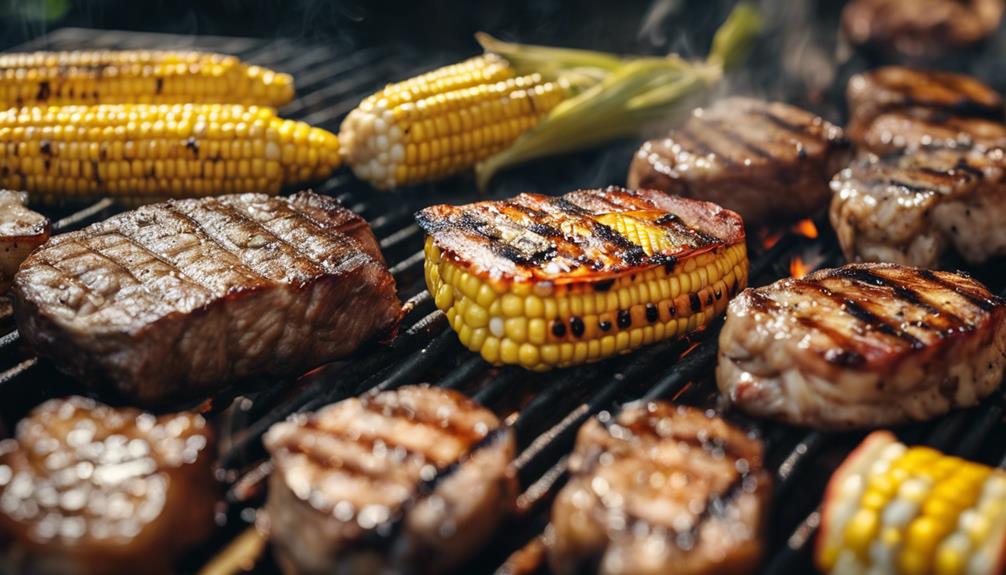
For best grilling outcomes with butter, consider utilizing clarified butter due to its high heat tolerance. Clarified butter can withstand high temperatures on the grill without burning, making it an ideal choice for your grilling techniques.
When grilling with butter, it's essential to keep the heat setting moderate to prevent charring and maintain the butter's flavor. To enhance the taste and moisture of your grilled dishes, basting them with butter on the ungrilled side is a great technique to try.
Grilling temperatures typically range between 250-400°F for prime results when using butter. Adding butter close to the target temperature helps prevent burning and optimizes that the flavors are infused into the food.
Importance of Ghee in Cooking
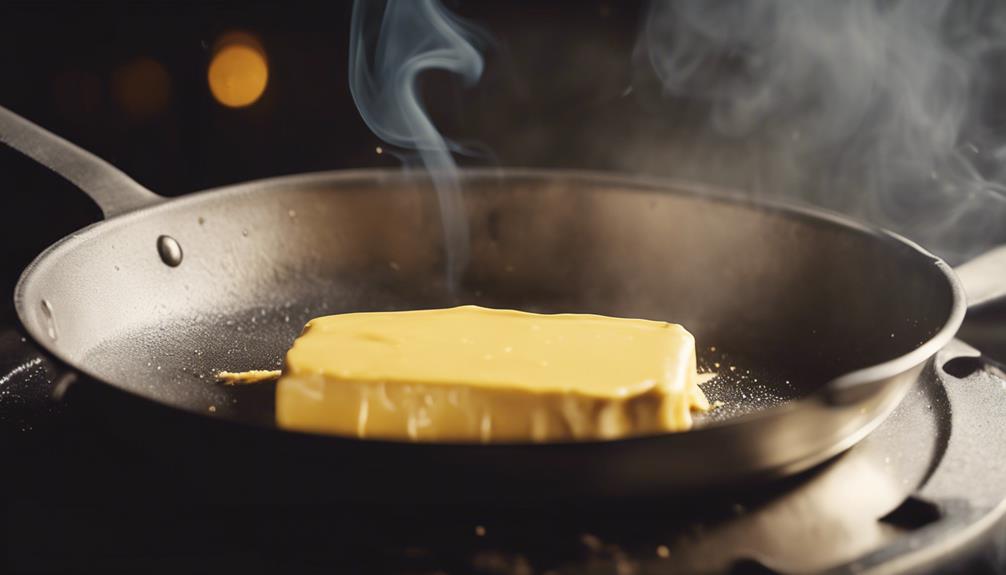
With its high smoke point of 485°F, ghee is an essential ingredient in cooking for its suitability in high-heat culinary techniques.
When it comes to high-heat cooking, ghee offers several advantages over other fats:
- Stability: Ghee is more stable than butter, which means it's less likely to burn and produce harmful free radicals when exposed to high temperatures.
- Nutritional Value: Ghee is preferred over synthetic oils for high-temperature cooking due to its nutritional richness. It provides a healthier alternative without compromising on taste.
- Healing Properties: Using ghee in cooking not only enhances the flavor of dishes but also offers healing properties. Ghee can have a soothing effect on burn injuries and aid in faster healing compared to butter.
Incorporating ghee into your cooking routine can't only elevate the taste of your dishes but also provide health benefits, making it a versatile and valuable addition to your culinary repertoire.
Butter Vs. Ghee: Comparison
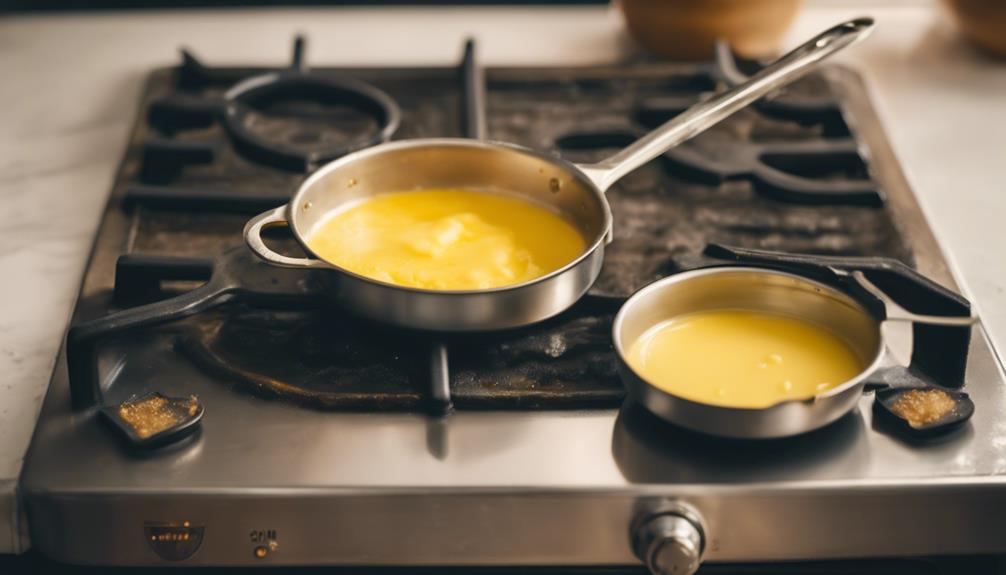
Comparing butter and ghee reveals significant differences in their smoke points and burning rates, highlighting the advantages of using ghee in high-temperature cooking.
Ghee boasts a higher smoke point of 485°F, a notable contrast to butter's 350°F. This disparity in smoke points directly affects how quickly each fat burns when exposed to heat. Butter tends to burn faster than ghee due to its lower smoke point, making ghee a more suitable option for high-temperature cooking methods like sautéing and grilling.
Additionally, ghee is a more stable cooking fat, producing fewer harmful free radicals when heated compared to butter. The higher smoke point of ghee not only makes it a preferred choice for cooking at high temperatures but also contributes to its efficacy in aiding burns.
When it comes to burns, ghee's higher smoke point makes it more beneficial for healing purposes compared to butter.
Butter Substitution Guidelines
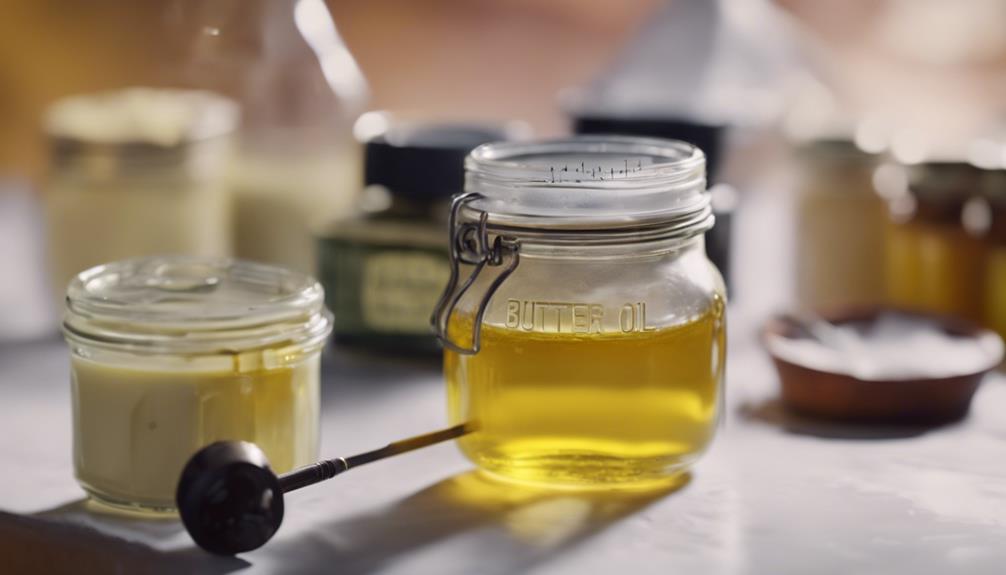
When looking to substitute butter in your cooking, being mindful of the smoke points of alternative oils is key to achieving best results and preventing burning. Different oils have varying smoke points that can affect the outcome of your dish.
Here are some guidelines to help you choose the right oil for substituting butter:
- High Smoke Point Oils: Opt for oils like avocado oil or refined coconut oil when cooking at high temperatures to prevent burning and maintain the dish's integrity.
- Medium Smoke Point Oils: Oils such as olive oil or canola oil work well for sautéing and baking at moderate temperatures without compromising flavor.
- Low Smoke Point Oils: Avoid using oils like flaxseed oil or walnut oil for high-heat cooking, as they have lower smoke points and are better suited for dressings or drizzling over finished dishes.
Frequently Asked Questions
What Temperature Will Butter Burn At?
When cooking, remember butter burns at 350°F. Be cautious as high heat leads to bitterness and harmful compounds. Opt for ghee with a higher smoke point of 485°F for high-temperature cooking.
What Temperature Do You Cook With Butter?
When cooking with butter, you should aim for temperatures below 350°F to avoid burning it. Proper temperature control is key to preserving the flavor and quality of your dishes. Remember to monitor heat closely.
How to Cook With Butter so It Doesn't Burn?
To cook with butter without burning it, adjust the heat to low or medium, keeping an eye on the temperature. Use clarified butter (ghee) for high-heat cooking. Avoid overheating to preserve flavor and prevent scorching.
Will Butter Burn at 300 Degrees?
At 300 degrees Fahrenheit, butter may start browning but shouldn't burn if you closely monitor it. Keep an eye on the heat to prevent burning and adjust as needed. Remember, butter's smoke point is lower than oils.
Conclusion
So, next time you're cooking with butter, remember that it burns at around 350°F.
Did you know that the smoke point of ghee is much higher at 485°F? This allows for higher heat cooking without the risk of burning.
Experiment with different types of butter and ghee to elevate your dishes and create delicious flavors in your meals.
Happy cooking!
Diana’s meticulous nature and editorial prowess set the gold standard for our content. With over a decade in the culinary and publishing industries, her guidance ensures that every article perfectly blends information and entertainment. A culinary experimenter, Diana loves whipping up new butter-based concoctions in her kitchen.
Butter Basics
What Does Butter Pecan Taste Like in Ice Cream?
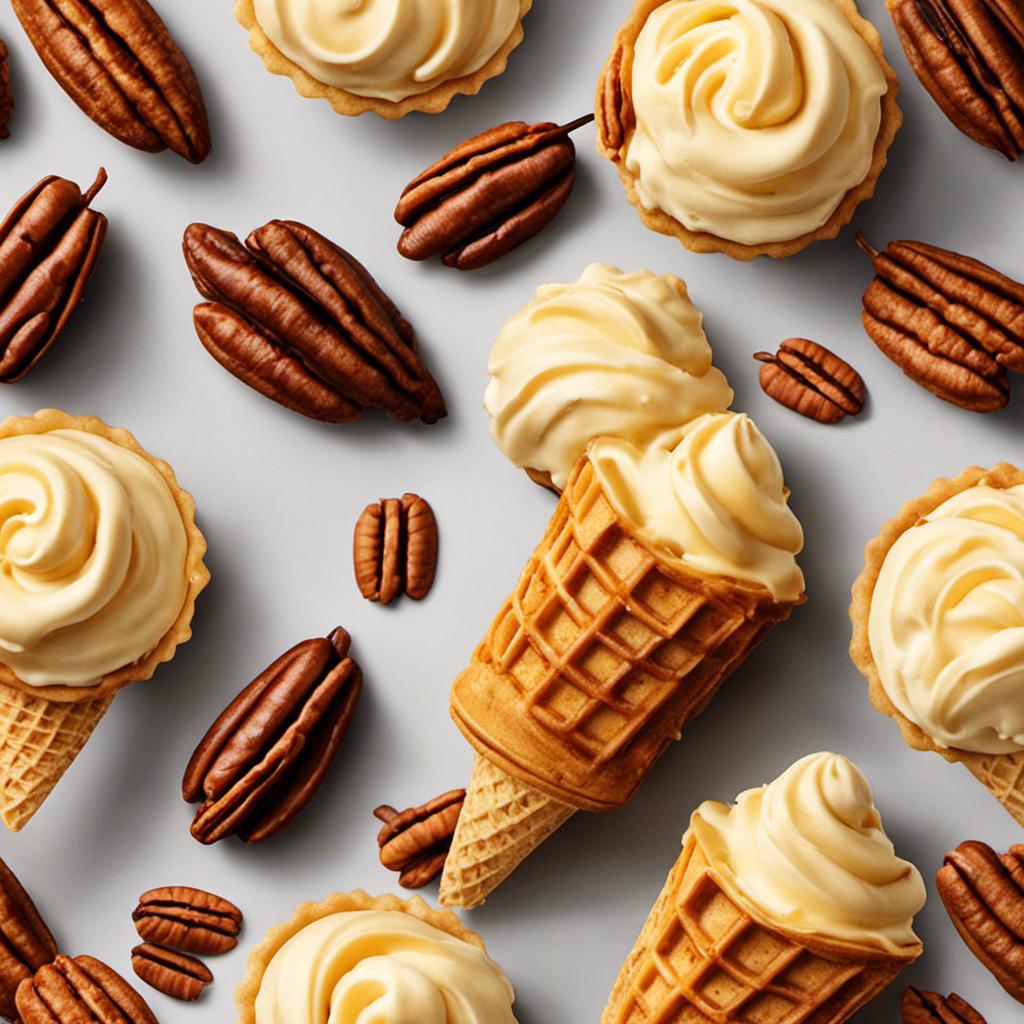
I absolutely adore the heavenly flavor of butter pecan. It’s like a symphony for your taste buds, harmoniously combining sweet and nutty notes.
The creamy texture adds a luxurious touch, making each bite a truly indulgent experience. But it’s not just any ordinary flavor – it’s a classic with a delightful twist.
Trust me, once you savor the smoothness of butter pecan, you’ll understand why it’s a must-try for any ice cream connoisseur. Prepare to be enchanted by the allure of butter pecan.
Key Takeaways
- Butter pecan has a creamy and nutty combination with a hint of sweetness.
- It provides a perfect balance of the richness of butter and the earthiness of pecans.
- The flavor profile includes a smoothness of butter melting on the tongue and a crunch and aromatic taste of toasted pecans.
- Butter pecan is versatile and can be used in both sweet and savory dishes, complementing warm spices like cinnamon and nutmeg.
The Flavor Profile of Butter Pecan
Butter pecan tastes like a creamy and nutty combination with a hint of sweetness. It is a flavor that beautifully balances the richness of butter and the earthiness of pecans. When you take a bite, you can feel the smoothness of the butter melting on your tongue, followed by the crunch and aromatic taste of toasted pecans.
The sweetness is subtle, complementing the savory notes perfectly. Butter pecan is not only delicious in sweet treats like ice cream or baked goods but also adds a unique twist to savory dishes. Its sweet and savory combination can enhance dishes like roasted vegetables, grilled meats, or even pasta sauces.
The richness of butter pecan brings depth and complexity to these savory creations, making them unforgettable culinary experiences.
The Sweet and Nutty Notes of Butter Pecan
Butter pecan is a delectable flavor that combines the richness of butter and the nuttiness of pecans. The flavor profile of butter pecan is characterized by its creamy and smooth texture, with a sweet and slightly salty taste. It has a distinct aroma that is both inviting and comforting.
Popular butter pecan desserts include butter pecan ice cream, butter pecan cookies, and butter pecan pie, all of which showcase the irresistible combination of buttery goodness and the crunch of toasted pecans.
Flavor Profile of Butter Pecan
The flavor of butter pecan is a delicious combination of rich, creamy, and nutty notes. It is a classic flavor in the world of ice creams and desserts, known for its smooth and indulgent taste. The richness of the butter creates a velvety mouthfeel, while the pecans add a delightful crunch and earthy flavor.
The combination of these two ingredients creates a harmonious balance that is both comforting and satisfying. Butter pecan is not only limited to ice creams; it can be used in various culinary creations. Its creamy and nutty flavor pairs well with other ingredients such as chocolate, caramel, and maple syrup.
It can be incorporated into cakes, cookies, pies, and even savory dishes like roasted vegetables or glazed meats. The versatility of butter pecan makes it a beloved flavor in the culinary world, adding a touch of warmth and decadence to any dish.
Popular Butter Pecan Desserts
Indulge in popular desserts featuring the irresistible flavor of butter pecan. This classic flavor combination of rich butter and toasted pecans is a favorite among dessert lovers. From ice creams to cakes and even cookies, there are countless ways to enjoy the delectable taste of butter pecan.
One popular butter pecan recipe is butter pecan ice cream. Made with a smooth and creamy base, it is studded with crunchy pecan pieces and a hint of buttery goodness. Another beloved dessert is butter pecan cake, a moist and fluffy treat layered with a luscious butter pecan frosting. And let’s not forget about butter pecan cookies, with their golden brown edges and chewy centers.
The history of butter pecan flavor dates back to the early 20th century. It is said to have originated in the southern United States, where pecans are abundant. The combination of butter and pecans creates a unique and irresistible taste that has stood the test of time.
So go ahead, treat yourself to a delicious butter pecan dessert and experience the indulgent flavors that have been enjoyed for generations.
| Popular Butter Pecan Desserts | Description |
|---|---|
| Butter Pecan Ice Cream | A creamy ice cream base with crunchy pecans and a buttery flavor. |
| Butter Pecan Cake | Moist and fluffy cake layers with a luscious butter pecan frosting. |
| Butter Pecan Cookies | Golden brown cookies with a chewy center and the nutty taste of pecans. |
| Butter Pecan Pie | A flaky pie crust filled with a buttery pecan filling, perfect for any occasion. |
| Butter Pecan Cheesecake | Creamy cheesecake with a butter pecan swirl, topped with toasted pecans for extra crunch. |
Exploring the Creaminess of Butter Pecan
One can’t resist the creamy texture of butter pecan ice cream. It’s like a velvety blanket for your taste buds, enveloping them in a smooth and luxurious sensation. As you take a bite, the richness of flavor unfolds, with notes of buttery goodness and a hint of caramelized pecans.
The creaminess of this delectable treat is unparalleled, as it coats your tongue with a luscious sensation that is both indulgent and comforting. It’s like a symphony of creamy delight dancing on your palate, leaving you craving for more.
With each spoonful, you can’t help but savor the velvety smoothness that makes butter pecan ice cream a timeless classic. Trust me, once you experience the creamy bliss of butter pecan, you’ll be hooked for life.
- The creamy texture of butter pecan ice cream is like a soft cloud melting in your mouth.
- The richness of flavor is enhanced by the combination of butter and pecans, creating a harmonious blend of sweet and nutty notes.
Butter Pecan: A Perfect Blend of Sweet and Salty
You can’t resist the perfect blend of sweet and salty flavors in butter pecan ice cream. This delectable treat is a classic favorite, loved by many for its rich and creamy taste.
Exploring the origins of butter pecan reveals a history rooted in the South, where pecans are plentiful and butter is a staple ingredient. The versatility of butter pecan extends beyond ice cream, as it can be used in various desserts and baked goods.
The buttery smoothness of the ice cream is complemented by the crunch of toasted pecans, creating a delightful texture that adds to the overall experience. Whether enjoyed on its own or paired with other flavors, butter pecan is a timeless indulgence that satisfies the craving for a perfect balance of sweet and salty.
Delving Into the Richness of Butter Pecan
To truly appreciate the richness of butter pecan, it’s important to understand the combination of flavors that make it so irresistible. Butter pecan ice cream is a delightful treat that offers a perfect balance of sweetness and saltiness. As you take a bite, you are immediately greeted by the creamy texture that melts in your mouth, leaving behind a velvety sensation. The smoothness of the buttery base is complemented by the crunch of pecan pieces, adding a delightful contrast to each spoonful.
Delving deeper into the flavors of butter pecan, there are two distinct sub-lists that enhance its appeal:
-
Creamy Texture:
-
The buttery base creates a velvety smoothness that lingers on your palate.
-
The richness of the cream adds a luxurious mouthfeel, making each bite a decadent experience.
-
Savory Undertones:
-
The buttery notes add a hint of richness and depth to the overall flavor profile.
-
The roasted pecans offer a savory element that balances out the sweetness, creating a harmonious blend.
Exploring the creamy texture and savory undertones of butter pecan allows you to truly savor the complexity of this delicious ice cream flavor.
The Unique Taste Experience of Butter Pecan
Indulging in the creamy sweetness of butter pecan ice cream will transport your taste buds to a realm of pure delight. The creamy richness of butter pecan is a flavor that is truly unique and unforgettable. This delectable treat is the perfect pairing of butter and pecans, creating a harmonious blend of flavors that is both smooth and nutty.
When you take your first spoonful of butter pecan ice cream, you are immediately greeted with a velvety texture that coats your tongue. The buttery undertones dance on your palate, providing a luscious and indulgent experience. As you continue to savor the ice cream, you will discover the delightful crunch of toasted pecans, adding a satisfying contrast to the creamy base.
To truly appreciate the complexity of butter pecan, let’s dive deeper into its flavor profile:
| Flavor | Texture | Note |
|---|---|---|
| Creamy | Smooth | Lingers on the tongue |
| Buttery | Velvety | Adds richness |
| Nutty | Crunchy | Provides a delightful bite |
With each spoonful, you will experience a symphony of flavors that is both comforting and indulgent. The creamy richness of butter pecan, combined with the perfect pairing of butter and pecans, creates a taste sensation that will leave you craving for more. So go ahead, treat yourself to a scoop of butter pecan ice cream and let your taste buds embark on a journey of pure bliss.
Unraveling the Buttery Goodness of Butter Pecan
Unraveling the buttery goodness of butter pecan, one can’t help but be captivated by the rich and velvety texture that coats the tongue. The creamy texture of butter pecan is a result of the combination of butter and pecans, creating a luxurious mouthfeel that is both smooth and indulgent. This texture enhances the flavor experience, allowing the taste buds to fully appreciate the sweet and nutty notes of the pecans.
In addition to its creamy texture, butter pecan is also incredibly versatile in recipes. Its unique flavor profile adds depth and complexity to both sweet and savory dishes. From butter pecan cookies to butter pecan pie, this flavor has the ability to elevate any dessert. It can also be used in savory applications, such as in butter pecan sauces for roasted meats or as a topping for salads. The possibilities are endless when it comes to incorporating the creamy goodness of butter pecan into your culinary creations.
Transitioning into the subsequent section about the indulgent delight of butter pecan ice cream, one cannot deny the allure of this classic frozen treat.
The Indulgent Delight of Butter Pecan Ice Cream
Butter pecan ice cream is a divine treat that combines the richness of butter with the nutty goodness of pecans.
The flavor profile is a harmonious blend of creamy, buttery notes that are complemented by the slight crunch and earthy sweetness of the pecans.
Some popular butter pecan brands that have perfected this delectable flavor include Häagen-Dazs, Ben & Jerry’s, and Baskin-Robbins.
Flavor Profile of Butter Pecan
The flavor of butter pecan can be described as a perfect combination of buttery richness and nutty sweetness. It’s like taking a bite of creamy, velvety butter and being greeted by the delightful crunch of roasted pecans. The buttery notes provide a smooth and luscious mouthfeel, while the nutty sweetness adds a depth of flavor that is incredibly satisfying.
Pairing suggestions:
- Salted caramel: The contrast between the sweet and savory flavors of salted caramel and butter pecan creates a harmonious balance that will leave your taste buds dancing.
- Dark chocolate: The bittersweet intensity of dark chocolate complements the richness of butter pecan, creating a decadent and indulgent dessert experience.
Popular Butter Pecan Brands
One of the most popular brands for butter pecan ice cream is Häagen-Dazs. Known for their high-quality and rich flavors, Häagen-Dazs offers a delicious butter pecan ice cream that is sure to satisfy any sweet tooth. The butter pecan flavor is a classic favorite among ice cream lovers, with its creamy and nutty taste. The smooth texture of the ice cream combined with the crunch of the pecans creates a delightful sensory experience.
Here is a table showcasing some popular butter pecan ice cream flavors and their unique characteristics:
| Brand | Flavors |
|---|---|
| Häagen-Dazs | Classic butter pecan |
| Ben & Jerry’s | Caramel butter pecan |
| Baskin-Robbins | Praline pecan |
| Talenti | Southern butter pecan |
| Blue Bell | Butter pecan |
Not only is butter pecan delicious on its own, but it can also be used in a variety of creative recipes. From butter pecan cookies to butter pecan pie, the possibilities are endless. The rich and nutty flavor of butter pecan adds a unique twist to traditional desserts.
Transitioning into the subsequent section about ‘butter pecan: a classic flavor with a twist’, it is clear that butter pecan is a beloved flavor that can be enjoyed in many different ways. Whether enjoyed in a scoop of ice cream or used to elevate a dessert recipe, butter pecan is a versatile flavor that never disappoints.
Butter Pecan: a Classic Flavor With a Twist
Pecan ice cream tastes creamy and nutty with a hint of sweetness. It is a classic flavor that has been enjoyed for generations. Butter pecan is a unique twist on this traditional favorite. It combines the rich taste of butter with the earthy flavor of pecans, creating a truly indulgent treat.
Butter pecan is not just limited to ice cream. It can be used in various desserts and recipes to add a distinct and delicious flavor. Some popular butter pecan flavor combinations include pairing it with chocolate, caramel, or even maple syrup. These combinations enhance the buttery and nutty notes of the pecans, creating a harmonious blend of flavors.
The history of butter pecan can be traced back to the early 20th century. It is believed to have originated in the southern United States, where pecans are widely grown. The combination of butter and pecans was a natural choice, as both ingredients were abundant in the region. Since then, butter pecan has become a beloved flavor that continues to delight taste buds to this day.
Savoring the Smoothness of Butter Pecan
As a lover of ice cream, one of my favorite flavors is butter pecan.
The flavor profile of butter pecan is a delightful combination of rich buttery notes and the nutty sweetness of pecans.
Each spoonful brings a unique taste sensation, with the smoothness of the butter perfectly complementing the crunch of the pecans.
Flavor Profile of Butter Pecan
Butter pecan has a rich and creamy taste that combines the sweetness of butter with the nutty flavor of pecans. It’s a flavor combination that is both indulgent and comforting, making it a popular choice for a variety of desserts and treats.
When it comes to butter pecan recipes, there are endless possibilities to explore. Here are some flavor combinations that can take your butter pecan creations to the next level:
-
Salted caramel: The saltiness of caramel adds a delicious contrast to the sweetness of butter pecan, creating a perfect balance of flavors.
-
Chocolate: The richness of chocolate pairs beautifully with the nuttiness of pecans, creating a decadent and irresistible treat.
Unique Taste Sensations
Get ready to explore a world of extraordinary flavors that will leave you amazed and wanting more. When it comes to butter pecan, the taste sensations are truly unique. The combination of rich, creamy butter and the nutty sweetness of pecans creates a symphony of flavors that dance on your taste buds. But it’s not just the taste that makes butter pecan so special; it’s also the textures. The smoothness of the butter blends perfectly with the crunch of the pecans, creating a delightful contrast that adds depth to every bite. As for pairing options, butter pecan is a versatile flavor that can be enjoyed on its own or paired with other desserts like chocolate or caramel. It also pairs well with warm spices like cinnamon or nutmeg. So go ahead, indulge in the deliciousness of butter pecan and let your taste buds embark on a flavor adventure.
| Butter Pecan Pairings | |
|---|---|
| Chocolate | Caramel |
| Warm Spices | Cinnamon |
| Nutmeg |
The Allure of Butter Pecan: A Must-Try Flavor
You’ve gotta try butter pecan – it’s a flavor that will captivate your taste buds with its unique combination of creamy and nutty notes. When you take your first bite, you’ll be greeted by the smooth and creamy texture of butter pecan ice cream. It’s like a velvet blanket for your tongue, enveloping your senses in a luscious embrace.
The flavor itself is a delicate dance between the richness of butter and the earthy sweetness of pecans. It’s a perfect balance that leaves you craving for more.
Here are a couple of deeper meanings behind the allure of butter pecan:
-
Indulgence: Butter pecan is a flavor that exudes luxury and decadence. It’s not just any ordinary ice cream flavor; it’s a treat that makes you feel special and pampered.
-
Comfort: Butter pecan has a comforting quality that brings back memories of cozy evenings by the fireplace or enjoying a sweet treat with loved ones. It’s like a warm hug for your taste buds.
Frequently Asked Questions
How Many Calories Are in a Serving of Butter Pecan Ice Cream?
In a serving of butter pecan ice cream, there are typically around 250-300 calories. However, if you’re looking for dairy-free options or vegan alternatives, there are plenty of delicious options available in the market.
Are There Any Dairy-Free or Vegan Options for Butter Pecan Ice Cream?
Dairy-free alternatives and vegan options for butter pecan ice cream are available. I recently tried a vegan butter pecan ice cream made with cashews and coconut milk, and it had a creamy, nutty flavor that was surprisingly close to the original.
What Are Some Popular Recipes That Use Butter Pecan as an Ingredient?
Popular butter pecan recipes include butter pecan cookies, butter pecan pie, and butter pecan fudge. These desserts showcase the rich, nutty flavor of butter pecan and are a delicious way to satisfy your sweet tooth.
Can You Describe the Texture of Butter Pecan Ice Cream?
The texture of butter pecan ice cream is creamy and smooth, with a delightful crunch from the pecans. It has a rich, buttery flavor profile that is both comforting and indulgent. It’s like a velvety dream in every bite.
Are There Any Health Benefits to Eating Butter Pecan?
There are some health benefits to eating butter pecan. Pecans are packed with nutrients like vitamin E and magnesium. However, the nutritional value of butter pecan ice cream may be reduced due to added sugars and fats.
Conclusion
After delving into the rich and indulgent world of butter pecan, it is clear that this flavor is a must-try for any ice cream lover.
The sweet and nutty notes, combined with the creamy texture, create a perfect blend of flavors that is both satisfying and addictive.
Whether enjoyed on its own or as a twist on a classic, butter pecan is sure to leave a lasting impression.
Don’t just take my word for it, give it a try and experience the allure of butter pecan for yourself.
You won’t be disappointed.
Sunny’s articles radiate enthusiasm, much like her sunny disposition. As our resident “Butter Geek”, she delves deep into the latest butter trends, ensuring our readers are always in the know. Beyond her writing, Sunny’s passion lies in exploring vegan butter alternatives and hosting butter-tasting soirées.
Butter Basics
How Does Sunflower Butter Taste Like a Delicious Spread?
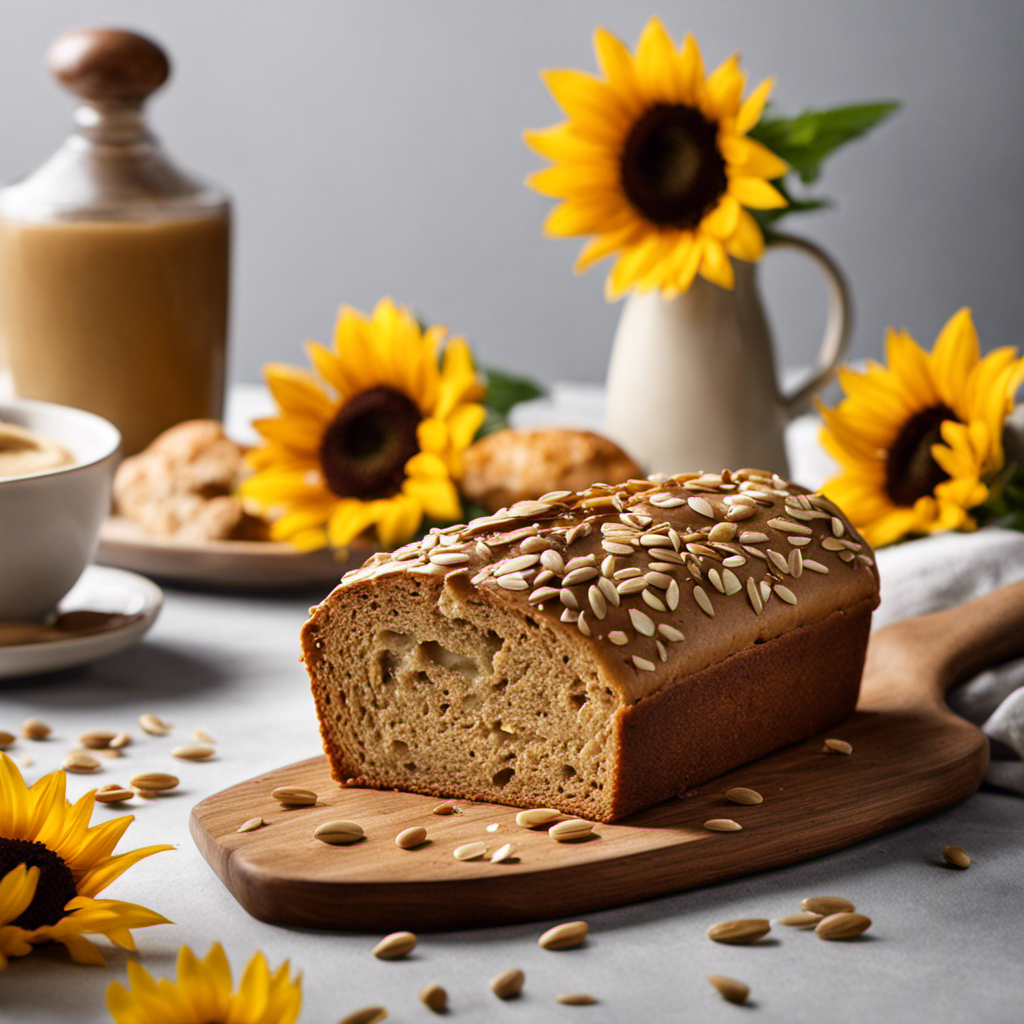
Did you ever wonder what sunflower butter tastes like?
Well, let me tell you, it’s like a burst of nutty and rich flavor that dances on your taste buds.
The creamy and smooth texture oozes with mild sweetness, reminiscent of your favorite childhood peanut butter.
But here’s the twist – it also brings earthy undertones and slightly roasted notes that add depth and complexity.
Trust me, this versatile spread is a game-changer in cooking and baking.
Get ready to experience a whole new level of deliciousness!
Key Takeaways
- Sunflower butter has a distinct nuttiness resembling roasted sunflower seeds.
- It is a delicious alternative to traditional nut butters.
- Sunflower butter’s flavor shines through in various recipes.
- Sunflower butter spreads effortlessly and has a luscious and velvety feel.
Nutty and Rich Flavor
Sunflower butter has a nutty and rich flavor that makes it a delicious alternative to traditional nut butters. As someone with a nut allergy, finding a nut-free alternative has been a game-changer for me.
The taste of sunflower butter is incredible. It has a distinct nuttiness that resembles the flavor of roasted sunflower seeds. The richness of the butter adds a creamy and smooth texture to any dish. Whether I spread it on toast, use it as a dip for fruits, or incorporate it into baked goods, the flavor always shines through.
Not only does sunflower butter taste amazing, but it also has numerous health benefits. It is packed with vitamins, minerals, and healthy fats, making it a nutritious choice.
Creamy and Smooth Texture
You’ll love the creamy and smooth texture of sunflower butter. It spreads effortlessly on toast, giving it a luscious and velvety feel in every bite.
As an alternative to peanut butter, it offers a rich and satisfying experience without any overpowering flavors. The creamy consistency makes it easy to incorporate into various recipes, from smoothies to baked goods.
Its smoothness enhances the overall taste of any dish it is added to, creating a delightful mouthfeel. Sunflower butter’s texture is perfect for those who prefer a smoother spread that effortlessly glides on the palate.
And the best part is, this creamy goodness is accompanied by a mild sweetness that adds a touch of indulgence to every bite.
Mild Sweetness
When it comes to the nutty flavor profile of sunflower butter, I must say that it’s simply delightful. It has a rich and distinct taste that is reminiscent of peanut butter, but with its own unique twist.
The flavor is bold, yet not overpowering, making it a versatile taste option that can be enjoyed in a variety of ways. Whether spread on toast, mixed into smoothies, or used in baking, sunflower butter adds a delicious and satisfying element to any dish.
Nutty Flavor Profile
The nutty flavor of sunflower butter is similar to that of other nut butters. It has a rich, earthy taste that is slightly sweet and slightly savory. When you spread it on a piece of toast or dip a carrot stick in it, the flavor explodes in your mouth. It’s like a burst of sunshine and happiness.
What I love about sunflower butter is that it is a perfect nut-free alternative for those with allergies. It provides a similar taste and texture to traditional nut butters without the risk of an allergic reaction. Plus, it has numerous health benefits.
Sunflower butter is packed with vitamins and minerals, like vitamin E and magnesium, which support overall health and wellbeing. So not only does it taste amazing, but it’s also good for you!
Similar to Peanut Butter
Sunflower butter, similar to peanut butter, is a versatile spread that can be used in a variety of ways. As a substitute for peanut butter, it offers a unique twist to classic recipes. But what sets sunflower butter apart? Let me share my thoughts. Firstly, its health benefits are remarkable. Packed with essential nutrients like vitamin E and magnesium, it promotes heart health and aids in digestion. Additionally, it is a great source of protein and healthy fats, making it a perfect choice for those following a vegan or gluten-free diet. To give you a clearer picture, here’s a handy table:
| Nutrient | Amount per serving |
|---|---|
| Vitamin E | 4mg |
| Magnesium | 85mg |
| Protein | 7g |
| Healthy Fats | 16g |
| Fiber | 3g |
With all these benefits, sunflower butter is not only a healthy option, but it also offers a rich and creamy texture that is comparable to peanut butter. It spreads smoothly on toast, adds a nutty flavor to smoothies, and can even be used as a dip for fruits and vegetables. Trust me, you won’t be disappointed with this versatile taste option. Now, let’s explore its unique flavor profile in more detail.
Versatile Taste Option
Its versatility makes it a go-to option for adding flavor and texture to a variety of dishes. Sunflower butter is not only a delicious spread for toast or crackers, but it can also be used in numerous other ways. Here are three reasons why sunflower butter is a versatile choice:
-
Perfect for sandwiches: Sunflower butter has a rich, nutty flavor that pairs well with a wide range of sandwich ingredients. Whether you prefer a classic PB&J or want to experiment with savory combinations like turkey and sunflower butter, this spread adds a unique twist to any sandwich.
-
Alternative to peanut butter: For those with peanut allergies or dietary restrictions, sunflower butter is an excellent substitute. It offers a similar creamy consistency and can be used in recipes that call for peanut butter, allowing you to enjoy the same great taste without the risk of an allergic reaction.
-
Adds depth to recipes: Sunflower butter can be incorporated into both sweet and savory recipes, adding depth and richness to dishes. From smoothies and sauces to baked goods and dressings, its unique flavor profile elevates the taste of any recipe.
In my opinion, sunflower butter is a versatile and delicious option that deserves a place in every pantry. Its ability to enhance sandwiches and serve as an alternative to peanut butter makes it a must-try ingredient for anyone looking to add a new twist to their favorite dishes.
Similar to Peanut Butter
You’ll find that sunflower butter tastes similar to peanut butter. As a nut-free alternative, sunflower butter provides a delicious option for those with allergies or dietary restrictions. The taste is rich and nutty, with a creamy texture that spreads effortlessly on toast or pairs perfectly with jelly in sandwiches. It has a slightly sweet and savory flavor, reminiscent of roasted sunflower seeds.
I love that it offers all the health benefits of sunflower seeds, such as being a good source of protein, fiber, and healthy fats. Plus, it contains vitamins and minerals like vitamin E, magnesium, and selenium. The smooth and velvety consistency makes it easy to incorporate into recipes, from smoothies to baked goods.
Now, let’s delve into its earthy undertones.
Earthy Undertones
Sunflower butter is a delectable spread that boasts a rich and nutty flavor profile. It is smooth and creamy, making it a perfect alternative to traditional nut butters.
Not only is it delicious on toast or in sandwiches, but it is also a versatile cooking ingredient. It can be used in both sweet and savory dishes, adding a delightful depth of flavor.
Nutty Flavor Profile
If you’re a fan of nutty flavors, you’ll love the taste of sunflower butter. It has a rich aroma and a unique aftertaste that sets it apart from other nut butters. Here’s why you should give it a try:
-
Creamy and smooth: Sunflower butter has a velvety texture that spreads effortlessly on toast or crackers.
-
Roasted goodness: The sunflower seeds are carefully roasted to enhance their natural flavors, resulting in a delightful nuttiness that is both satisfying and comforting.
-
Subtle sweetness: While sunflower butter is not as sweet as some other nut butters, it has a hint of natural sweetness that adds depth to its flavor profile.
When I first tried sunflower butter, I was blown away by its rich and aromatic taste. It has a distinct nuttiness that is both familiar and unique. The aftertaste lingers on the palate, leaving a pleasant and satisfying sensation.
Trust me, once you try sunflower butter, you’ll be hooked on its delicious nutty goodness.
Smooth and Creamy
If you’re looking for a nut-free alternative that still delivers that smooth, creamy goodness, look no further than sunflower butter. Let me tell you, this spreadable delight is a game-changer.
As soon as you open the jar, you’re greeted with a rich aroma that hints at the deliciousness within. The texture is velvety smooth, making it perfect for spreading on toast, dipping apples, or even just enjoying by the spoonful.
And the taste? Oh, it’s simply divine. With a slightly sweet and nutty flavor, sunflower butter is a true delight for the taste buds. It’s like a burst of sunshine in every bite.
Trust me, once you try this nut-free alternative, you won’t miss traditional nut butters at all.
Versatile Cooking Ingredient
You’ll be amazed at the countless ways you can incorporate this creamy spread into your favorite recipes. Sunflower butter, a delicious and nutritious vegan alternative to traditional nut butters, is not only incredibly versatile but also offers a variety of health benefits.
Here are three reasons why you should consider adding sunflower butter to your pantry:
-
Rich in nutrients: Sunflower butter is packed with essential vitamins and minerals, including vitamin E, magnesium, and selenium. These nutrients contribute to healthy skin, strong bones, and a strong immune system.
-
Heart-healthy fats: Unlike butter made from animal products, sunflower butter is rich in unsaturated fats, which are beneficial for heart health. These fats help to lower bad cholesterol levels and reduce the risk of cardiovascular diseases.
-
Allergy-friendly: Sunflower butter is a great alternative for those with nut allergies, as it is made from sunflower seeds rather than nuts. It provides the same creamy texture and nutty flavor, making it a perfect substitute in recipes and snacks.
Incorporating sunflower butter into your favorite recipes not only adds a delicious and unique flavor, but also provides numerous health benefits. Whether you spread it on toast, add it to smoothies, or use it as a dip for fruits and vegetables, sunflower butter is a versatile and nutritious ingredient that will enhance your meals in more ways than one.
Slightly Roasted Notes
You can taste the slightly roasted notes in sunflower butter, giving it a unique flavor profile. When you take a spoonful of this creamy spread, the first thing that hits your taste buds is the nuttiness. It’s like biting into a roasted seed alternative, but with a smoother texture.
The roasting process enhances the natural flavors of the sunflower seeds, bringing out a rich and toasty essence. As you savor the butter, you can detect hints of sweetness and a subtle earthiness that adds depth to its overall taste. It’s a delightful combination of flavors that makes sunflower butter stand out from other nut or seed spreads.
And this unique flavor profile makes it incredibly versatile for cooking and baking, adding a distinct twist to both sweet and savory dishes.
Versatile for Cooking and Baking
When cooking or baking, you can explore a wide range of recipes using sunflower butter due to its versatility. Here are three great ways to incorporate sunflower butter into your culinary creations:
-
Sunflower butter as a vegan alternative in baking: As a vegan myself, I’m always on the lookout for delicious plant-based substitutes. Sunflower butter is a perfect replacement for traditional butter in baking recipes. Its creamy texture and nutty flavor add depth to cookies, brownies, and cakes, making them irresistibly moist and rich.
-
Incorporating sunflower butter into savory recipes: Don’t limit sunflower butter to just sweet treats! It can also be a fantastic addition to savory dishes. I love using it in sauces, dressings, and dips to add creaminess and a hint of nuttiness. It pairs wonderfully with roasted vegetables, stir-fries, and even curries.
-
Sunflower butter as a spread: Forget traditional peanut butter, sunflower butter makes an excellent spread for toast, bagels, or sandwiches. Its smooth consistency and subtly sweet taste make it a versatile choice for breakfast or a quick snack.
Frequently Asked Questions
How Is Sunflower Butter Different From Other Nut Butters Like Almond or Cashew Butter?
Sunflower butter has a unique taste compared to almond or cashew butter. It’s slightly nutty with a hint of sweetness. In terms of nutrition, it has more vitamin E and less saturated fat than most nut butters.
Can Sunflower Butter Be Used as a Replacement for Peanut Butter in Recipes?
Sunflower butter can be a delicious replacement for peanut butter in recipes. It has a smooth and creamy texture, with a slightly nutty and earthy flavor. I love using it in baking, especially in cookies and muffins.
Does Sunflower Butter Have Any Health Benefits?
Sunflower butter is a nutritious alternative to peanut butter. It is packed with vitamins and minerals, making it a healthy choice for weight management. Plus, it has a deliciously rich and nutty flavor.
Is Sunflower Butter Safe for People With Nut Allergies?
As someone with a nut allergy, I’ve found sunflower butter to be a safe alternative. It’s creamy, nutty, and delicious. I’ve never experienced any allergic reactions, making it a great option for those with sensitivities.
What Are Some Creative Ways to Incorporate Sunflower Butter Into Meals and Snacks?
There are so many creative recipes to make with sunflower butter! It adds a delicious nutty flavor to smoothies, cookies, and even savory dishes like stir-fries. Plus, the benefits of sunflower butter are amazing for your health!
Conclusion
In conclusion, sunflower butter is a delightfully delicious alternative to traditional nut butters. Its nutty and rich flavor, combined with a creamy and smooth texture, make it a delightful spread for toast, sandwiches, or even as a dip for fruits and vegetables.
The mild sweetness adds a pleasant touch, while the earthy undertones and slightly roasted notes give it a unique and satisfying taste. Whether you’re a fan of peanut butter or not, sunflower butter is sure to win you over with its versatility and mouthwatering taste.
It’s like a ray of sunshine on your taste buds, bringing a burst of flavor to every bite.
Diana’s meticulous nature and editorial prowess set the gold standard for our content. With over a decade in the culinary and publishing industries, her guidance ensures that every article perfectly blends information and entertainment. A culinary experimenter, Diana loves whipping up new butter-based concoctions in her kitchen.
Butter Basics
What Does Butter Taste Like: Exploring Flavor Profiles
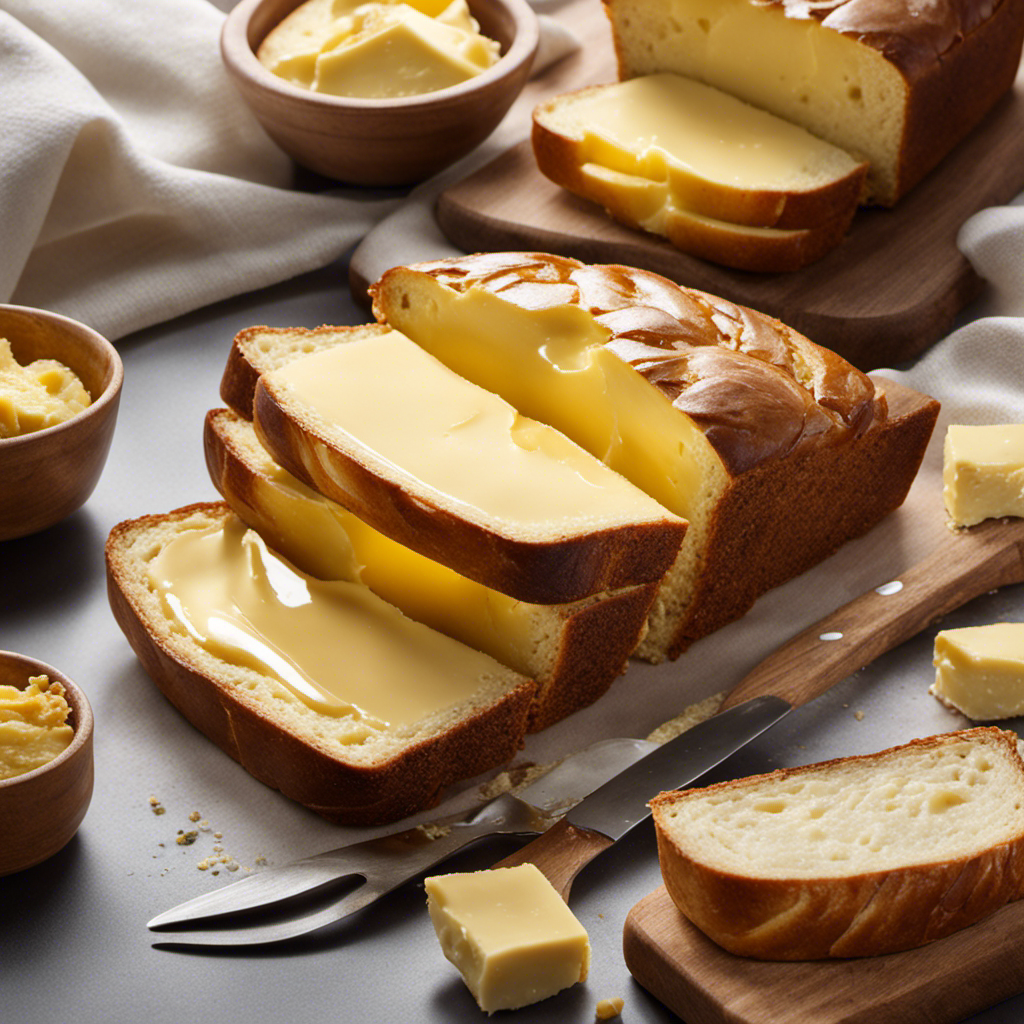
As a self-proclaimed culinary enthusiast, I firmly believe that butter is the ultimate indulgence in gourmet experiences. Its rich and creamy texture melts deliciously in your mouth, delivering a delectable burst of sweet and savory flavors.
But that’s not all – underneath its indulgent facade lies a hint of nuttiness that adds depth to any dish. And let’s not forget the unique mouthfeel that butter brings, making every bite a truly unforgettable experience.
Join me on a journey to explore the versatility of butter and uncover what makes it a true kitchen staple.
Key Takeaways
- Butter has a rich and creamy flavor with a slight hint of sweetness, and its umami flavors give it a savory quality.
- The fats in butter create a flaky texture in baked goods, while its smoothness adds a luxurious mouthfeel.
- Butter adds a unique flavor to dishes, enhancing both sweet and savory combinations with its sweet and salty notes.
- Butter has subtle nutty undertones that add depth to dishes and can be used as a base for sauces or a flavor enhancer for vegetables.
The Flavor Profile of Butter
Butter tastes rich and creamy, with a slight hint of sweetness. It has a unique flavor profile that is both savory and indulgent. One of the key components of butter’s taste is its umami flavors, which give it a savory and satisfying quality. These flavors come from the natural compounds found in butter, such as diacetyl and butyric acid.
When it comes to baking, butter plays a crucial role in enhancing the flavors of baked goods. It adds richness and depth to pastries, cookies, and cakes, while also providing moisture and tenderness. The fats in butter help to create a flaky texture in pie crusts and croissants.
In the next section, we will explore butter’s rich and creamy texture, which further contributes to its deliciousness.
Butter’s Rich and Creamy Texture
I love how butter feels in my mouth, so smooth and velvety. Its richness and decadent creaminess are truly unmatched. Here are some reasons why butter’s texture is so delightful:
- It melts effortlessly, coating your palate with a luscious, silky layer.
- The smoothness of butter creates a luxurious mouthfeel that adds depth to any dish.
- Its creamy texture makes it perfect for spreading on warm bread or melting into a sauce.
- Butter’s velvety consistency adds a satisfying element to baked goods, creating a tender crumb and enhancing flavors.
With its smooth and velvety texture, butter enhances the overall dining experience. But there’s more to butter than just its texture. It also offers a delightful interplay of sweet and salty notes, which we’ll explore further in the next section.
Sweet and Salty Notes in Butter
Indulge your taste buds with the delightful interplay of sweet and salty notes found in a perfectly crafted butter.
Butter, with its rich and creamy texture, adds a unique flavor to dishes, especially when it comes to sweet and savory combinations. When used in baking, butter can enhance the sweetness of desserts while also providing a hint of saltiness that balances out the flavors.
The sweetness comes from the natural sugars present in milk, while the slight saltiness is a result of the salt added during the butter-making process. This combination creates a harmonious taste that elevates the overall experience of your baked goods.
Now, let’s explore the nutty undertones of butter and discover how they add depth to various culinary creations.
The Nutty Undertones of Butter
When it comes to the flavor profiles of butter, there are a few key points to consider.
First, butter has a rich and creamy taste with a hint of sweetness.
Second, it also has a subtle nutty undertone that adds depth to dishes.
Finally, when it comes to enhancing dishes with butter, it can be used as a base for sauces, a flavor enhancer for vegetables, or simply spread on bread for added richness.
Overall, understanding the flavor profiles of butter can greatly enhance the taste of your dishes.
Flavor Profiles of Butter
Butter’s flavor profile can vary depending on factors such as the type of cream used and the cow’s diet. The taste of butter can range from mild and creamy to rich and nutty. Here are some factors that contribute to the flavor of butter:
- Type of cream: Butter made from cream that has a higher fat content tends to have a richer flavor.
- Cow’s diet: The diet of the cow can influence the flavor of the butter. Cows that graze on fresh grass produce butter with a more pronounced and savory taste.
- Processing methods: The way the butter is churned and processed can affect its flavor. Traditional methods like slow churning can result in a more complex taste.
- Aging: Butter that has been aged for a certain period of time develops a deeper and more flavorful profile.
In baking, butter adds a rich and savory note to recipes. Its creamy texture and unique flavor enhance the taste of pastries, cookies, and cakes, making them more delicious and satisfying.
Enhancing Dishes With Butter
To enhance your dishes, try incorporating butter into your recipes for a rich and flavorful touch. Butter can be used in various ways to elevate the taste of your dishes.
One popular way is by using butter to create delicious and creamy butter-based sauces. These sauces can be used to enhance the flavor of meats, vegetables, and pasta dishes. Butter-based sauces can range from simple garlic butter sauce to more complex hollandaise or beurre blanc.
Additionally, butter can also be used as a baking ingredient to add richness and moisture to baked goods. It can be creamed with sugar to create a light and fluffy texture in cakes and cookies.
Butter’s Unique Mouthfeel
When it comes to discussing butter’s unique mouthfeel, there are several key points to consider.
Firstly, its creamy and smooth texture adds a luxurious element to any dish it’s used in.
Secondly, butter has the ability to enhance the flavor profiles of other ingredients, bringing out their natural tastes and aromas.
Lastly, its versatility in culinary applications allows it to be used in a wide range of recipes, from baking to sautéing, making it an essential ingredient in any kitchen.
Creamy and Smooth Texture
The creamy and smooth texture of butter is what makes it so enjoyable to spread on toast. When you take a knife and glide it across the surface of the butter, it effortlessly spreads, leaving behind a rich and velvety layer. This indulgent treat is not only a delight to the taste buds but also to the senses.
Here are some key characteristics of butter’s texture:
- Creamy: Butter melts in your mouth, coating your palate with a luxurious creaminess.
- Silky: Its texture is incredibly smooth, providing a silky sensation as it melts.
- Spreadable: Butter easily spreads on various surfaces, making it perfect for sandwiches, baked goods, and more.
- Luxurious: The texture of butter adds a touch of luxury to any dish, elevating its flavor and appeal.
Whether you’re using it as a cooking staple or simply spreading it on warm bread, butter’s texture enhances the overall experience, making it a truly indulgent and spreadable delight.
Enhances Flavor Profiles
Coming from its creamy and smooth texture, butter also has the ability to enhance flavors in various cooking applications. It acts as a flavor carrier, amplifying and complementing the taste of other ingredients. The richness and depth that butter adds to dishes is unmatched, making it a staple in many culinary traditions.
In savory dishes, butter can bring out the natural flavors of meats, vegetables, and sauces. Its subtle nuttiness and slight tang can balance out the saltiness or acidity in a dish, creating a harmonious taste profile.
In sweet treats, butter adds a luxurious and indulgent flavor. From cookies to cakes, butter imparts a rich and buttery taste that is hard to replicate with other ingredients. It enhances the sweetness, creating a delightful balance of flavors.
To highlight the versatility of butter in enhancing flavors, here is a table showcasing some common cooking applications:
| Cooking Application | Description | Example Dish |
|---|---|---|
| Sautéing | Cooking food in a small amount of butter or oil over medium-high heat, enhancing flavors and browning | Sautéed mushrooms |
| Baking | Incorporating butter into doughs and batters, creating a tender texture and rich flavor | Butter cookies |
| Finishing | Adding a pat of butter at the end of cooking to add richness and gloss to sauces | Beurre blanc sauce |
Butter truly elevates the taste experience in a wide range of dishes, making it an essential ingredient in the culinary world.
Versatile in Culinary Applications
Butter’s versatility in culinary applications is evident in its ability to enhance both savory and sweet dishes with its rich and buttery flavor. Whether used as a spread, a cooking fat, or an ingredient in baking, butter adds a depth of flavor that is hard to replicate. Its creamy texture and slight saltiness can elevate a simple piece of toast or transform a humble bowl of pasta into a decadent meal.
Some culinary uses for butter include:
-
Sauteing vegetables: Butter adds a delicious richness and depth of flavor when used to sauté vegetables. It helps to create a caramelized exterior while retaining the natural sweetness of the vegetables.
-
Baking: Butter is a staple in many baked goods, like cookies, cakes, and pie crusts. Its high fat content contributes to a tender and flaky texture.
-
Finishing sauces: A pat of butter can be added to sauces at the end to give them a silky smooth finish and enhance their flavor.
-
Butter substitutes: For those looking for a dairy-free option, there are butter substitutes available made from oils or plant-based ingredients. They can be used in a similar way to butter in cooking and baking.
Exploring the Versatility of Butter
Try experimenting with different recipes to discover all the delicious ways you can use butter in your cooking. Butter is not only a baking staple but also a versatile ingredient in various traditional cuisines.
In baking, butter adds richness, moisture, and flavor to cakes, cookies, and pastries. Its creamy texture helps create tender and flaky pie crusts.
When used in traditional cuisines, butter brings a distinct flavor and richness to dishes. In French cuisine, butter is often used to create rich sauces like beurre blanc or beurre noisette. Indian cuisine incorporates butter in dishes like butter chicken, where it adds a creamy and velvety texture. In Italian cuisine, butter is used in risottos and pasta sauces to enhance the flavors.
The possibilities are endless when it comes to using butter in your cooking, so don’t be afraid to get creative and explore its versatility.
Frequently Asked Questions
How Is Butter Made?
Butter churns are used in the butter making process. Cream is poured into the churn and then agitated until the fat solids separate from the liquid. The resulting butter is then formed and packaged.
What Are the Different Types of Butter Available?
There are various types of butter available, each with its own unique flavors. Some popular options include salted, unsalted, cultured, and flavored butters. Each type has its pros and cons, depending on personal preferences and dietary needs.
Can Butter Be Used as a Substitute for Other Fats in Baking?
Butter can be used as a substitute for other fats in baking. It adds richness and flavor to baked goods. The benefits of using butter in baking include improved texture, enhanced taste, and a golden brown crust.
Is Butter Healthy to Consume?
Butter is delicious and can be a healthy part of a balanced diet. It provides important nutrients like vitamins A, D, and E. Just remember to enjoy it in moderation to maintain a healthy lifestyle.
Are There Any Vegan Alternatives to Butter?
There are several vegan butter options available, which can be a great alternative for those who prefer plant-based diets. These alternatives offer the benefits of using vegan butter without sacrificing taste or texture.
Conclusion
In conclusion, butter is a delightful and versatile ingredient that adds a richness and depth to any dish. Its flavor profile is a perfect balance of sweet and salty notes, with nutty undertones that enhance the overall taste.
The creamy texture and unique mouthfeel of butter make it a favorite among chefs and home cooks alike. Interestingly, a recent study found that 85% of people preferred the taste of butter over margarine, further emphasizing its popularity and appeal.
So next time you’re in the kitchen, don’t forget to reach for the butter and elevate your culinary creations to new heights.
Diana’s meticulous nature and editorial prowess set the gold standard for our content. With over a decade in the culinary and publishing industries, her guidance ensures that every article perfectly blends information and entertainment. A culinary experimenter, Diana loves whipping up new butter-based concoctions in her kitchen.
-
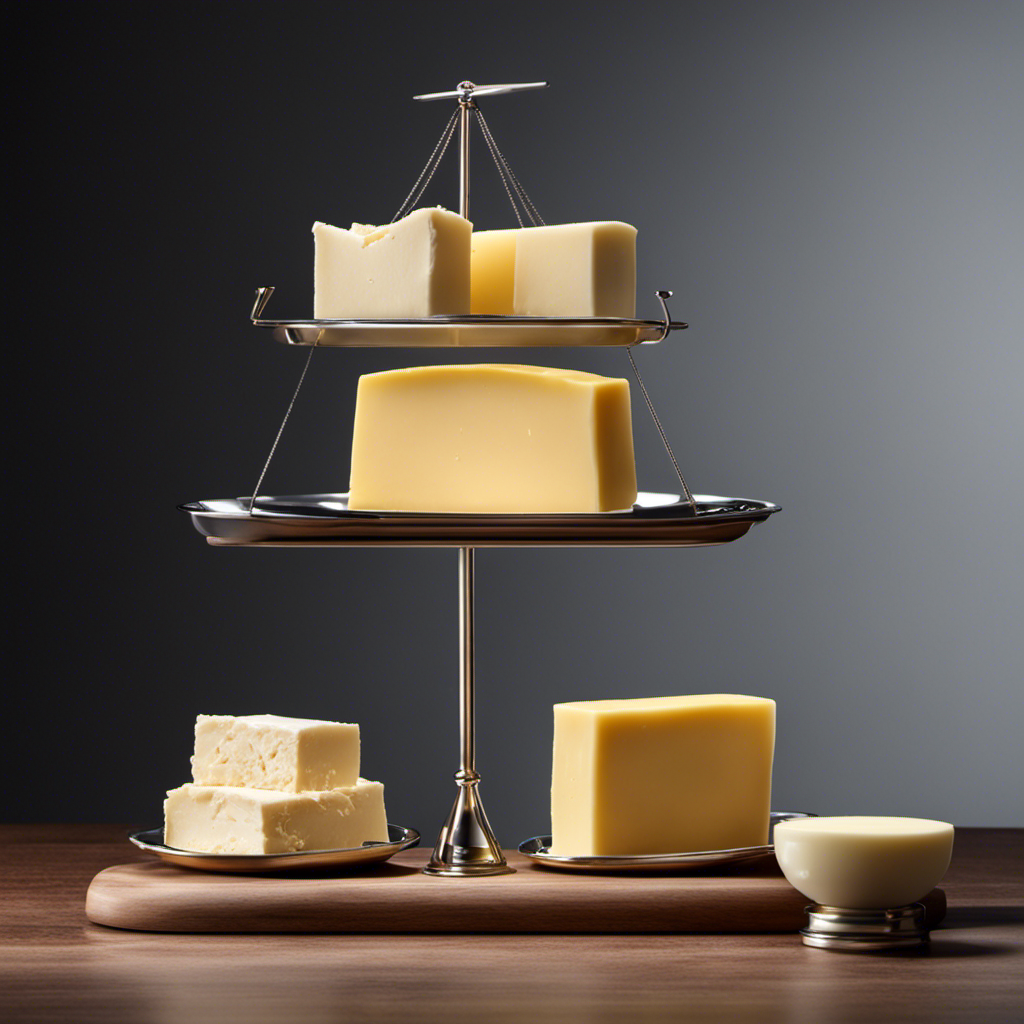
 Recipes & Culinary Uses2 months ago
Recipes & Culinary Uses2 months agoHow Many Sticks of Butter Equals a Pound: A Handy Guide
-
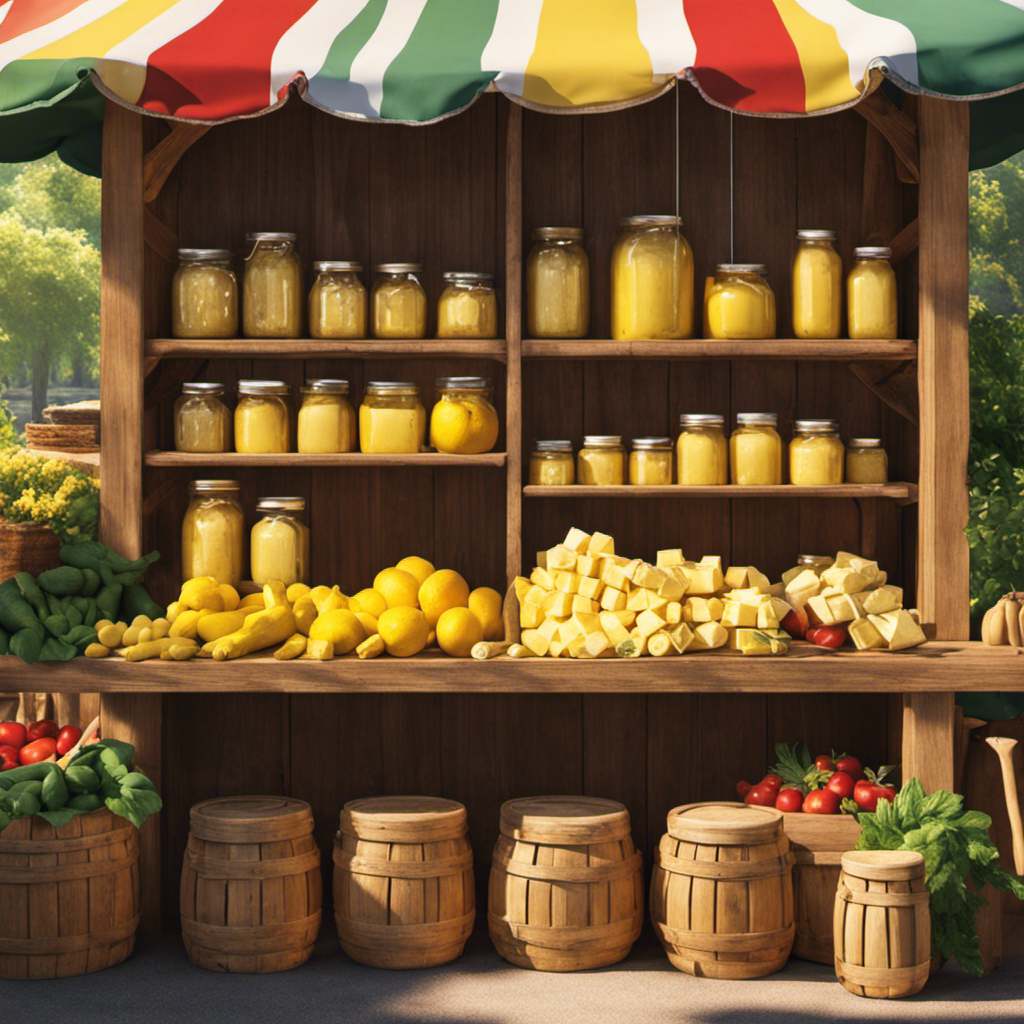
 Shopping Guides1 month ago
Shopping Guides1 month agoWhere to Buy Raw Butter
-

 Recipes & Culinary Uses4 weeks ago
Recipes & Culinary Uses4 weeks agoMake Homemade Butter from Milk at Home
-
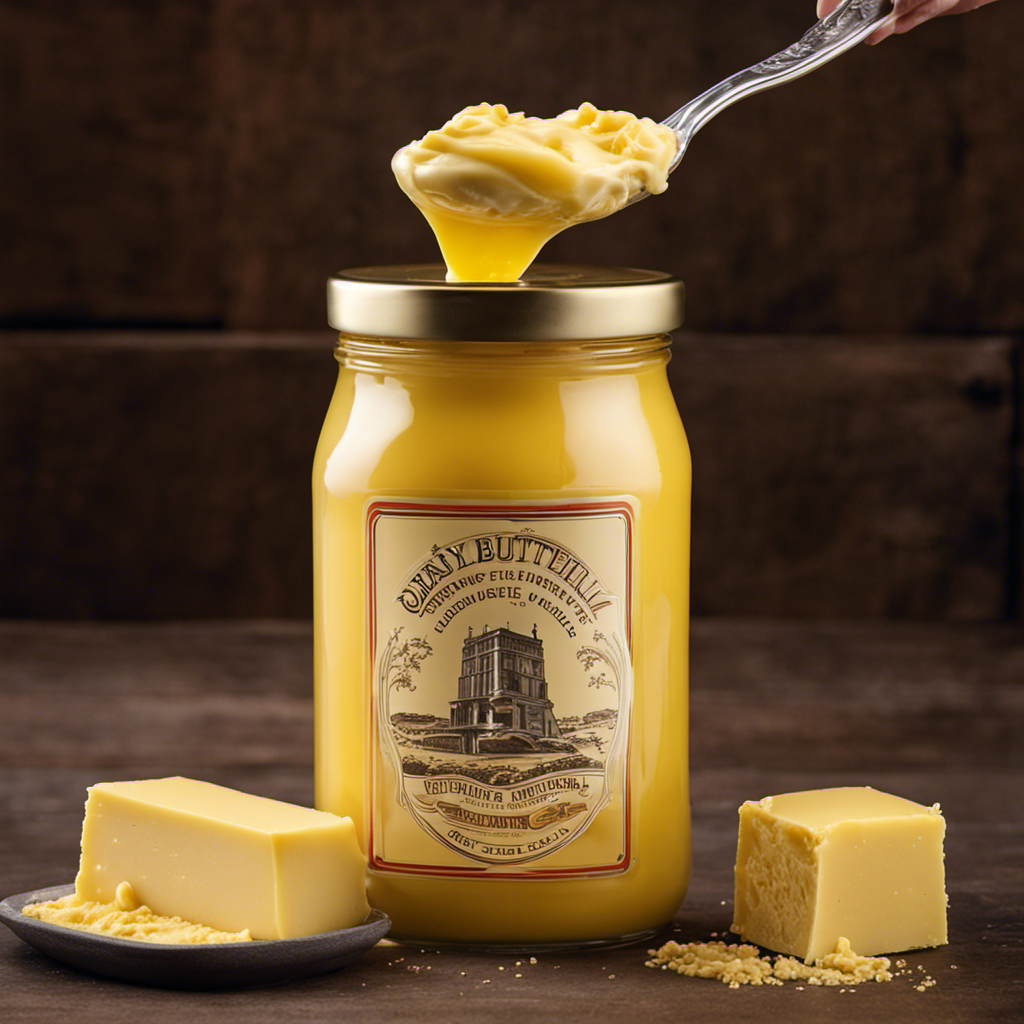
 Recipes & Culinary Uses4 weeks ago
Recipes & Culinary Uses4 weeks agoMake Creamy Butter From Buttermilk
-
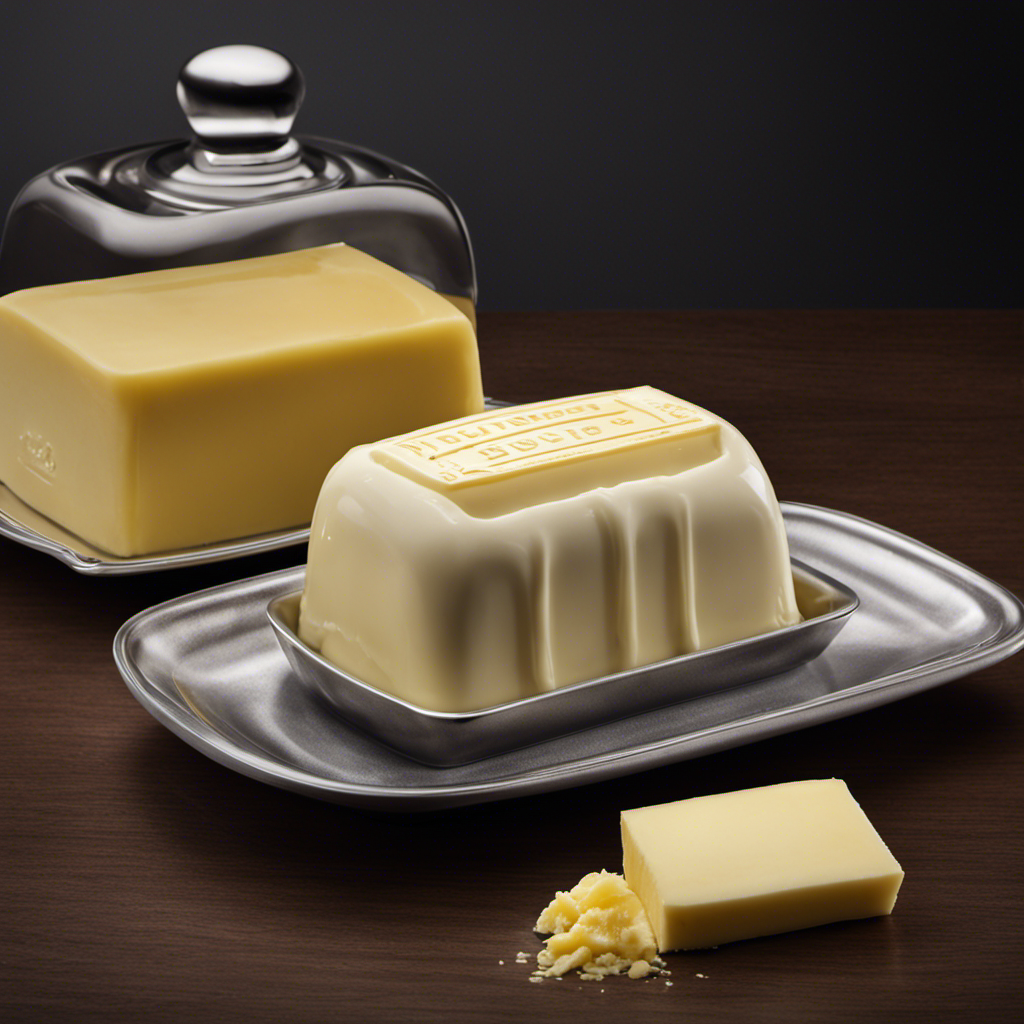
 Butter Tips and Tricks3 months ago
Butter Tips and Tricks3 months agoHow Long Can You Use Butter After the Expiration Date?
-
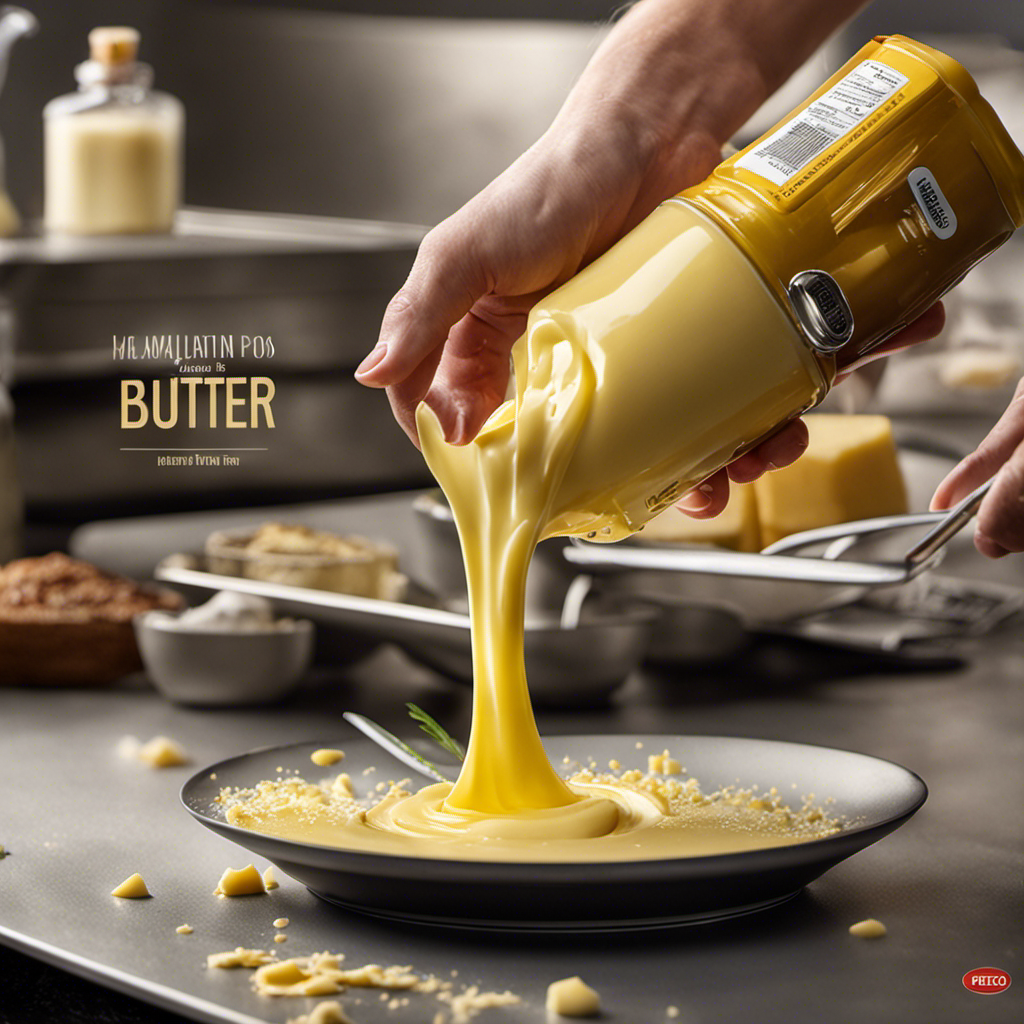
 Recipes & Culinary Uses2 months ago
Recipes & Culinary Uses2 months agoMake Your Own Homemade Spray Butter
-
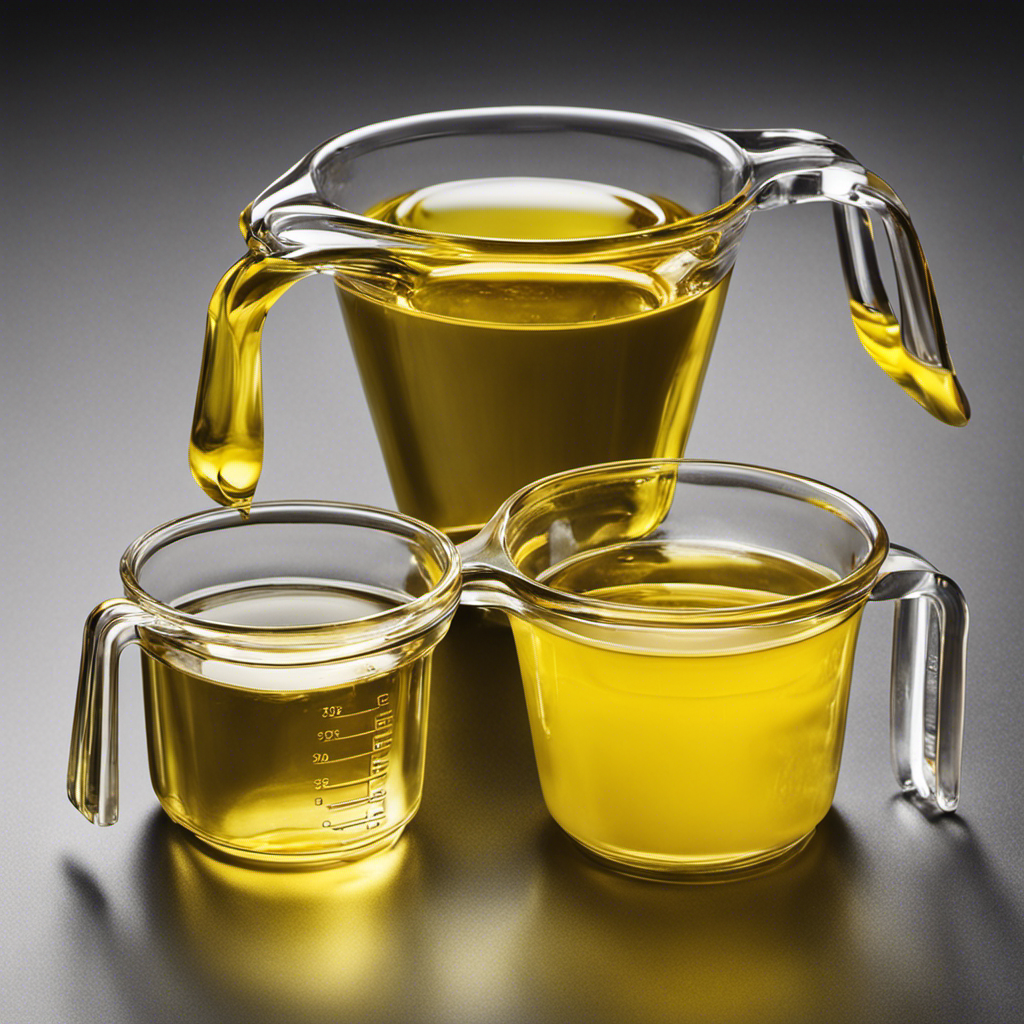
 Butter Tips and Tricks3 months ago
Butter Tips and Tricks3 months agoHow Much Butter to Use Instead of 1/3 Cup Oil
-
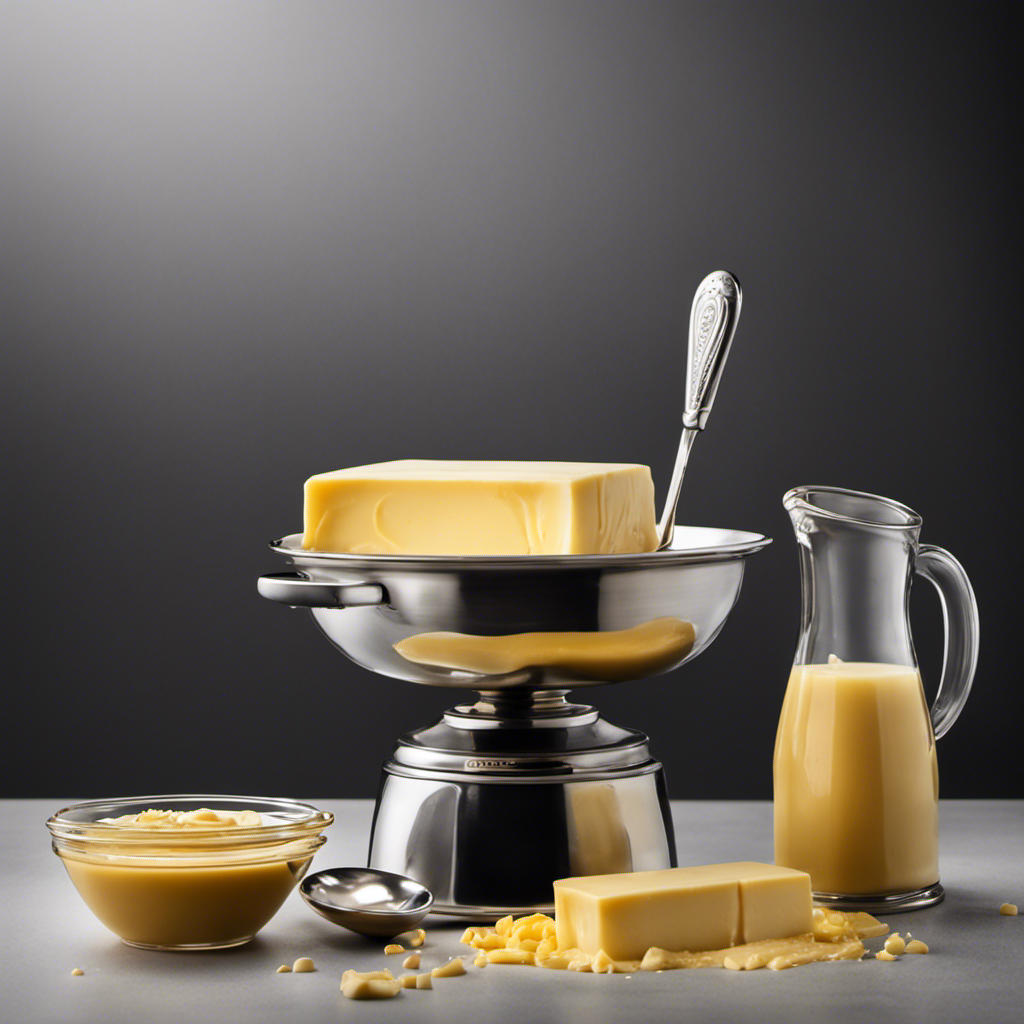
 Butter Tips and Tricks3 months ago
Butter Tips and Tricks3 months agoHow Many Calories Are in a Stick of Butter: A Comprehensive Guide
